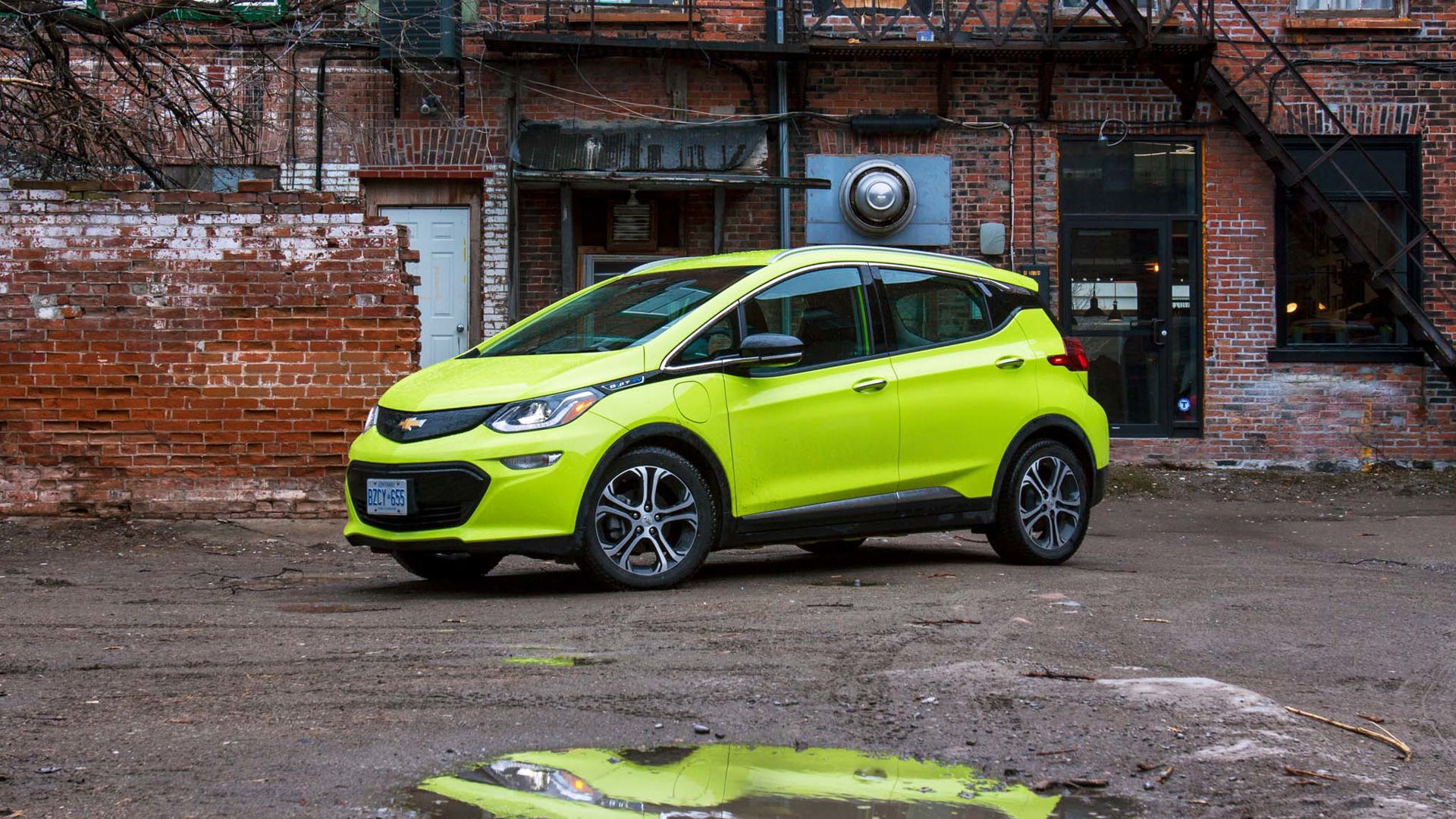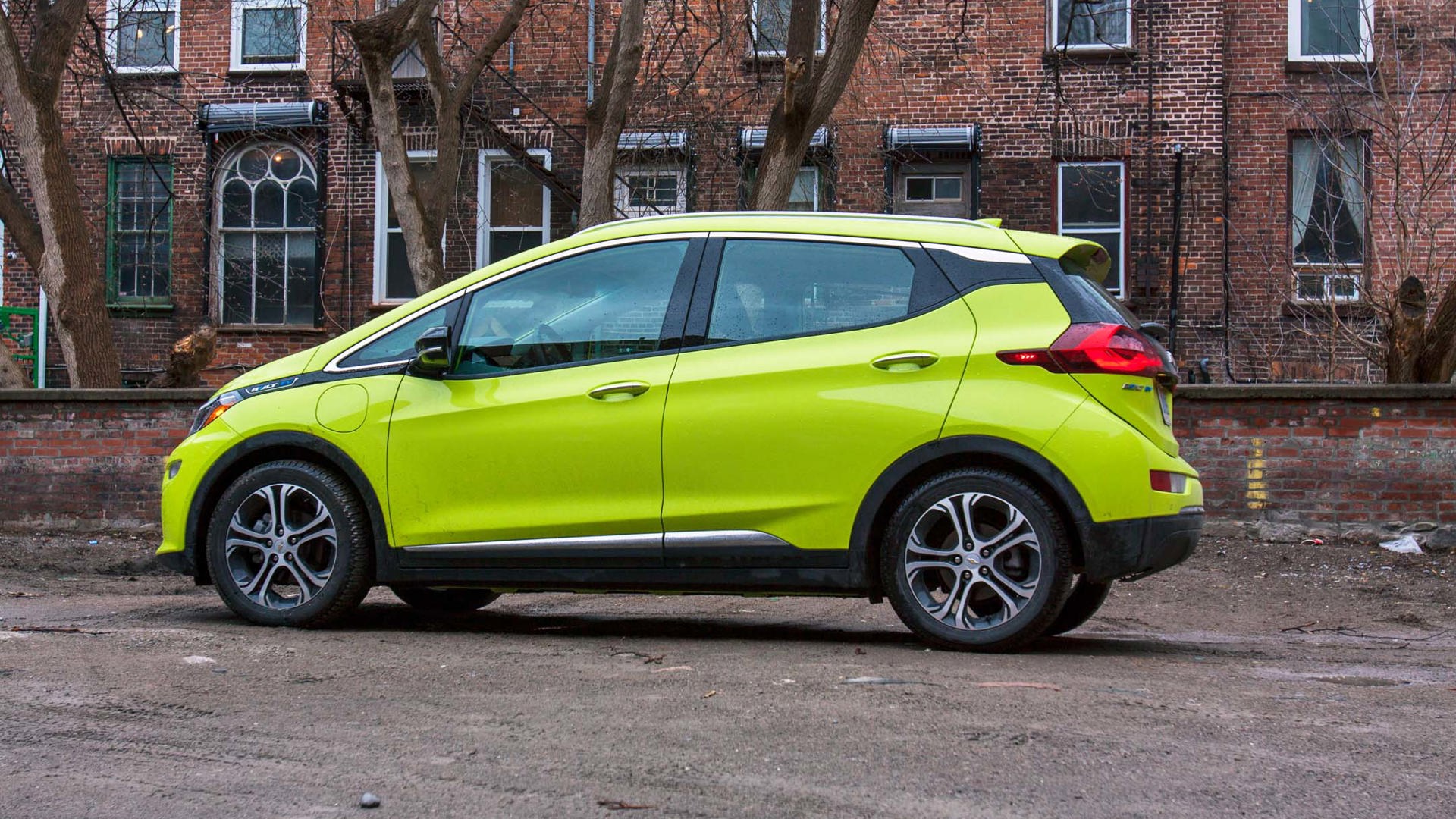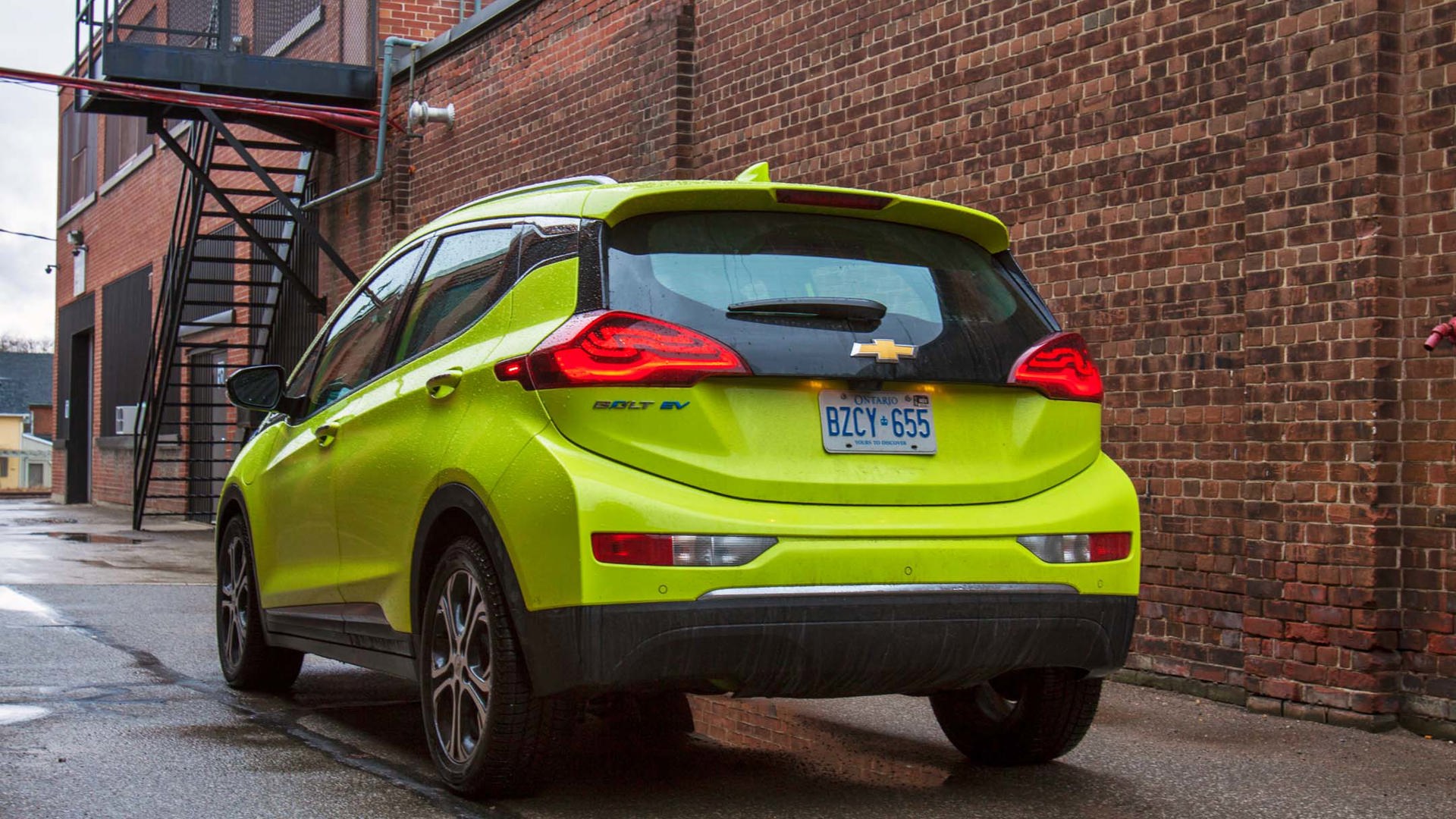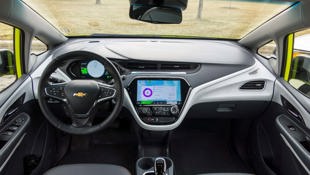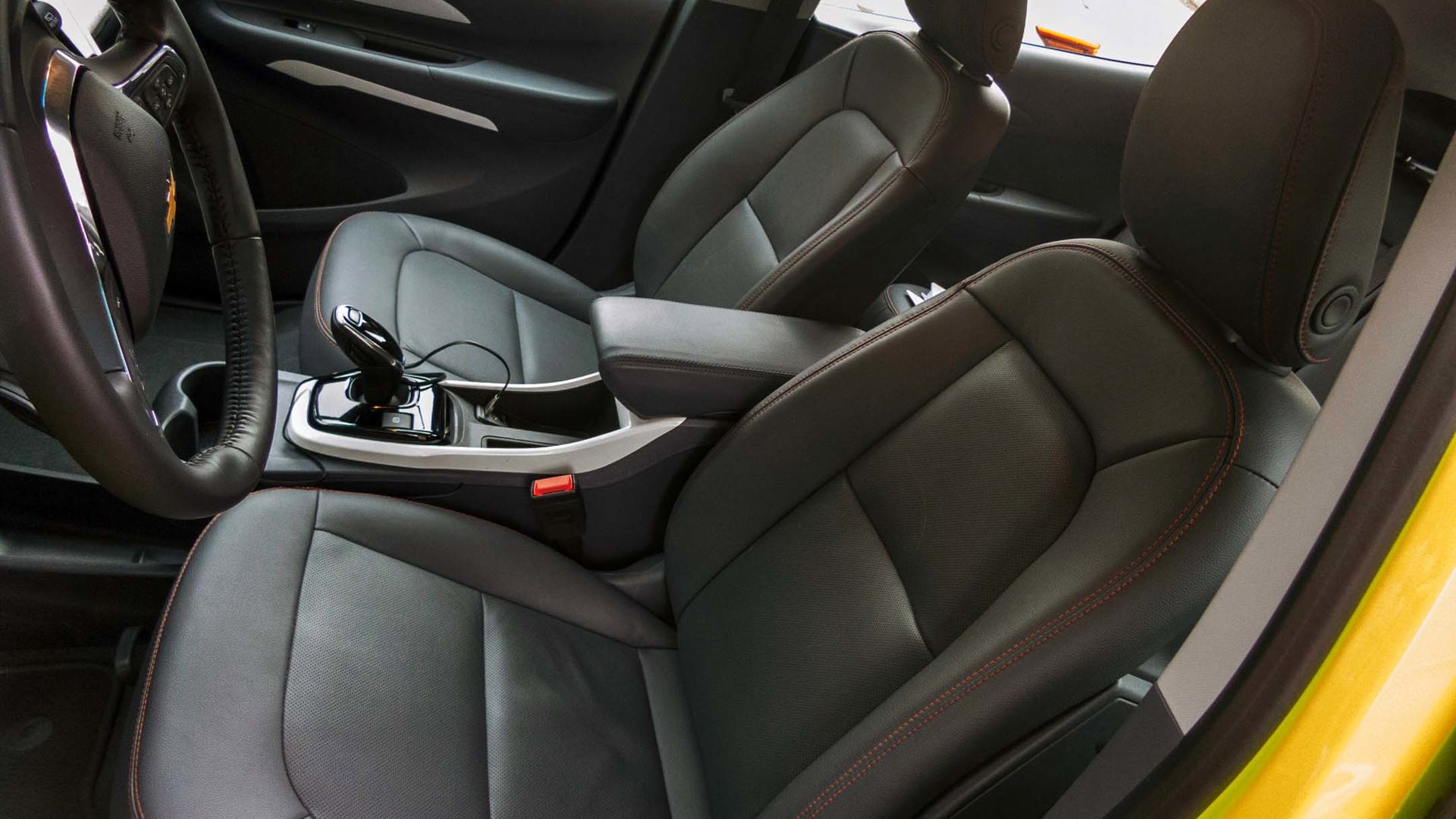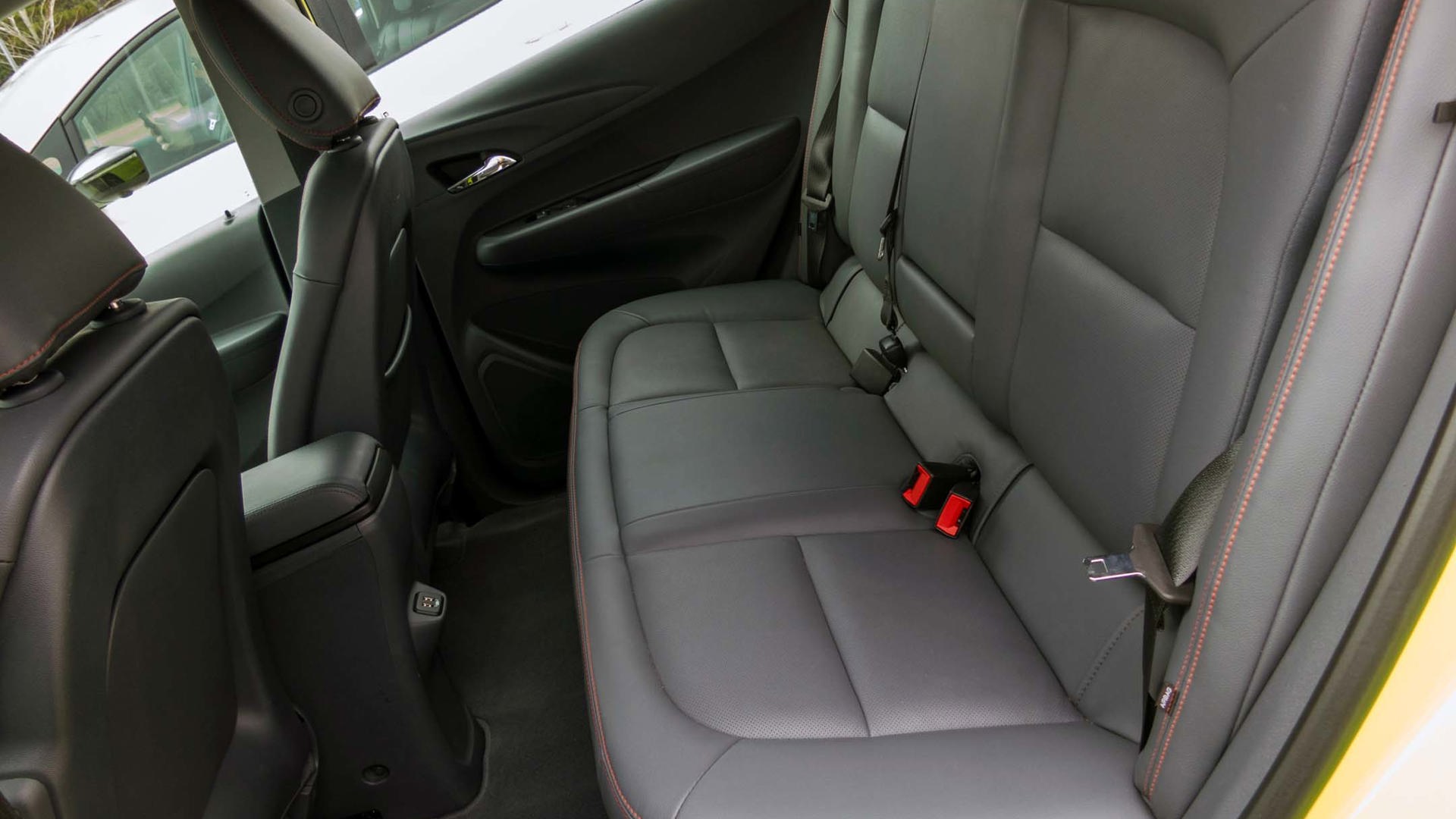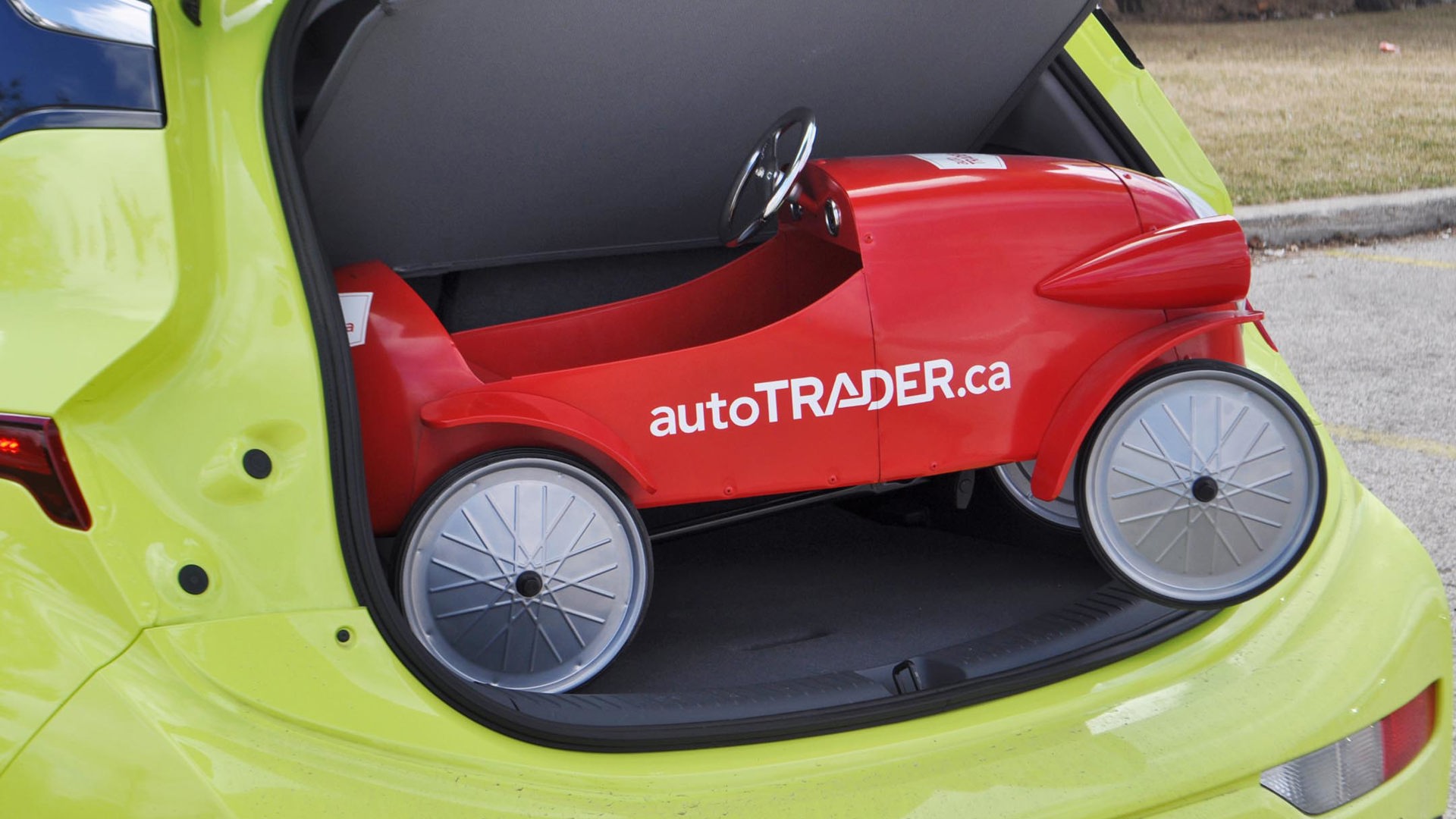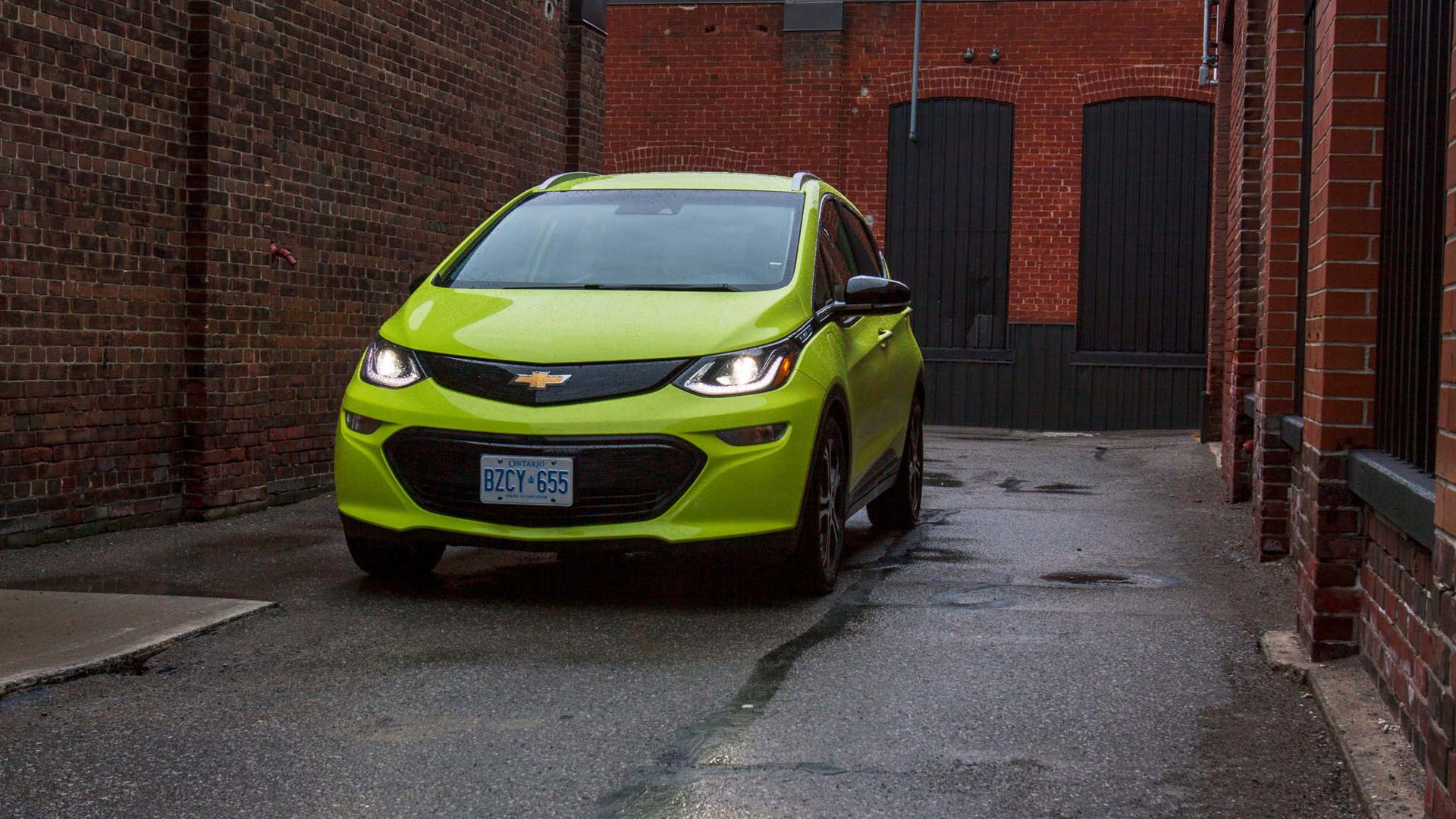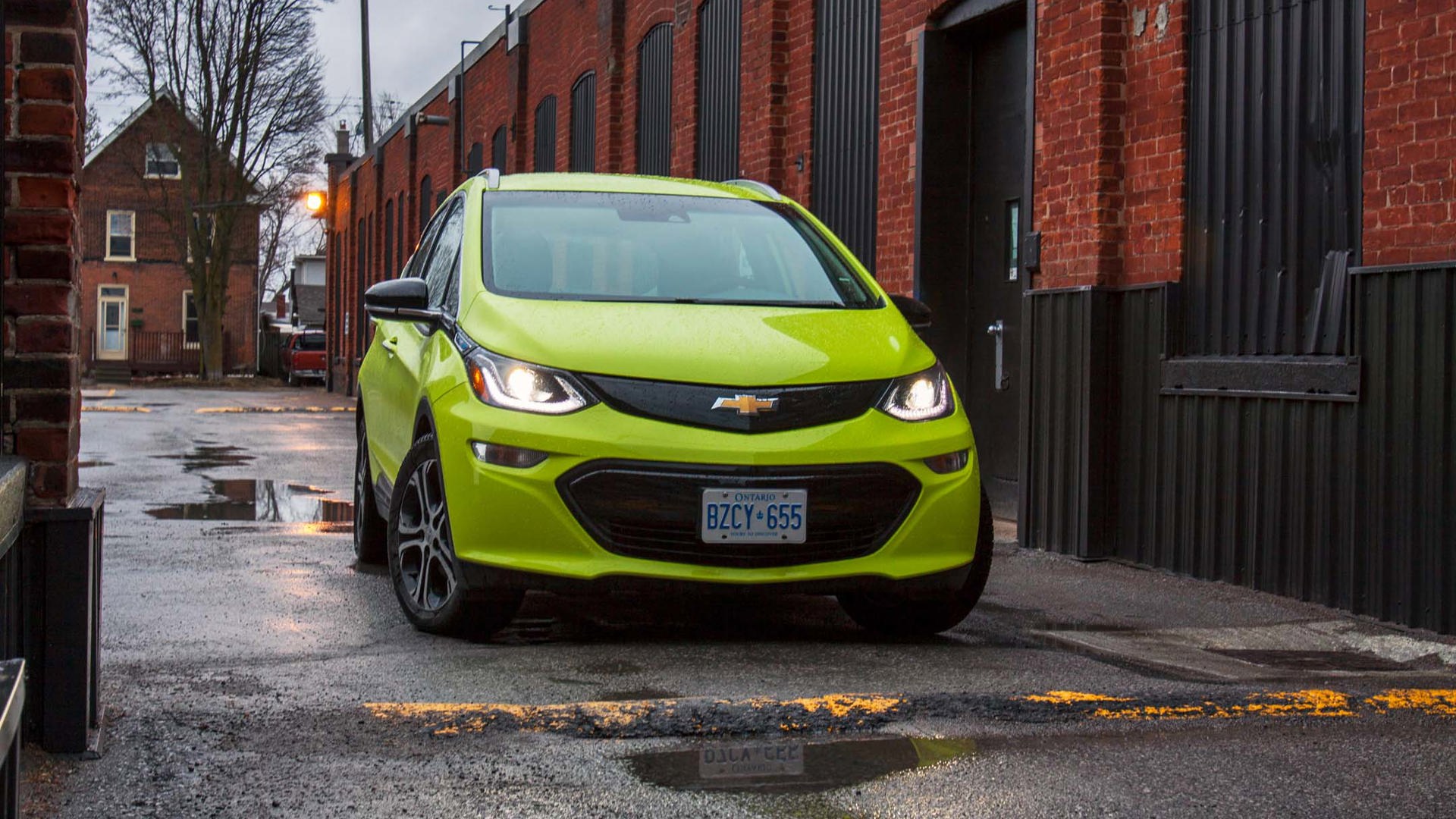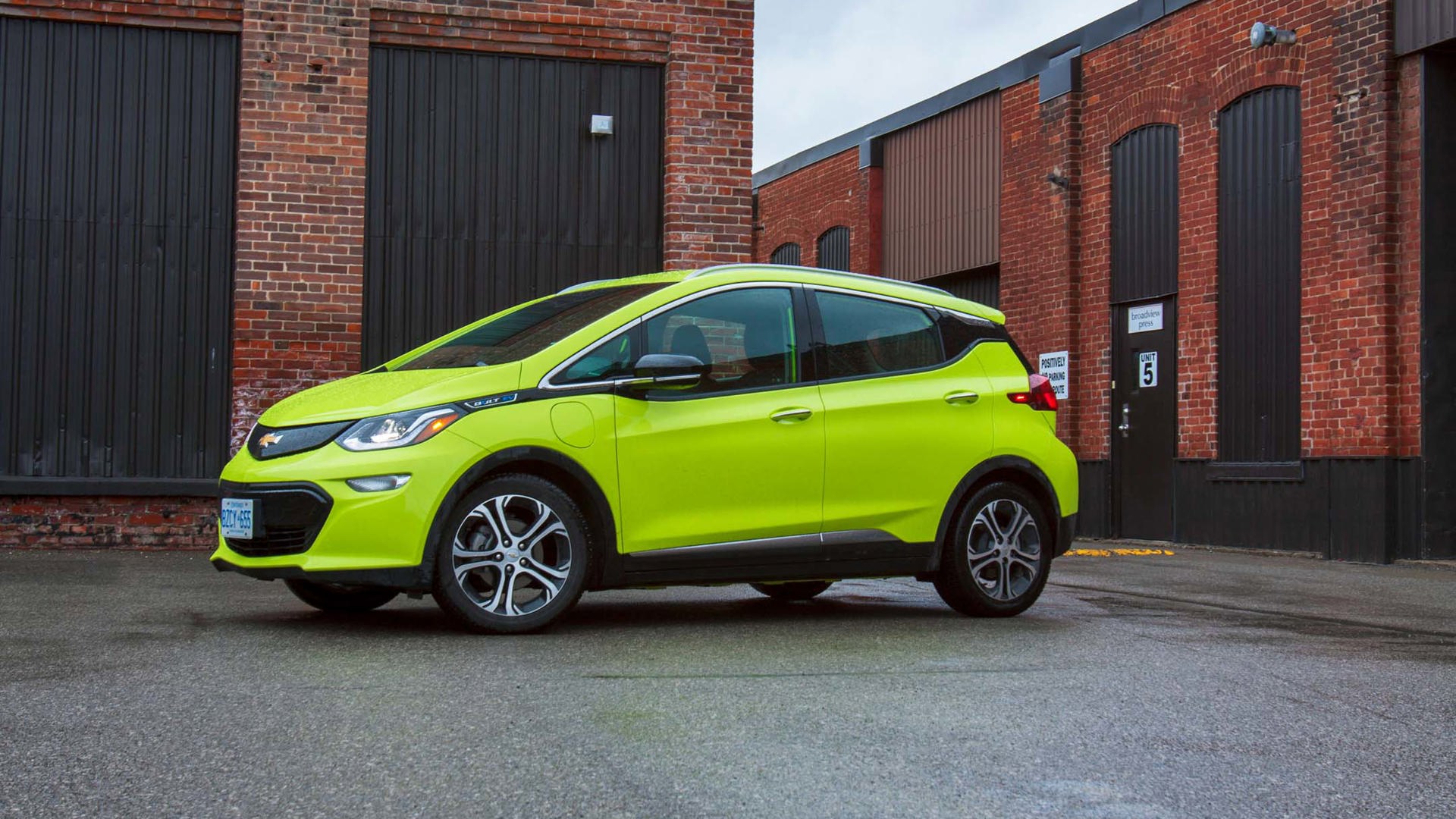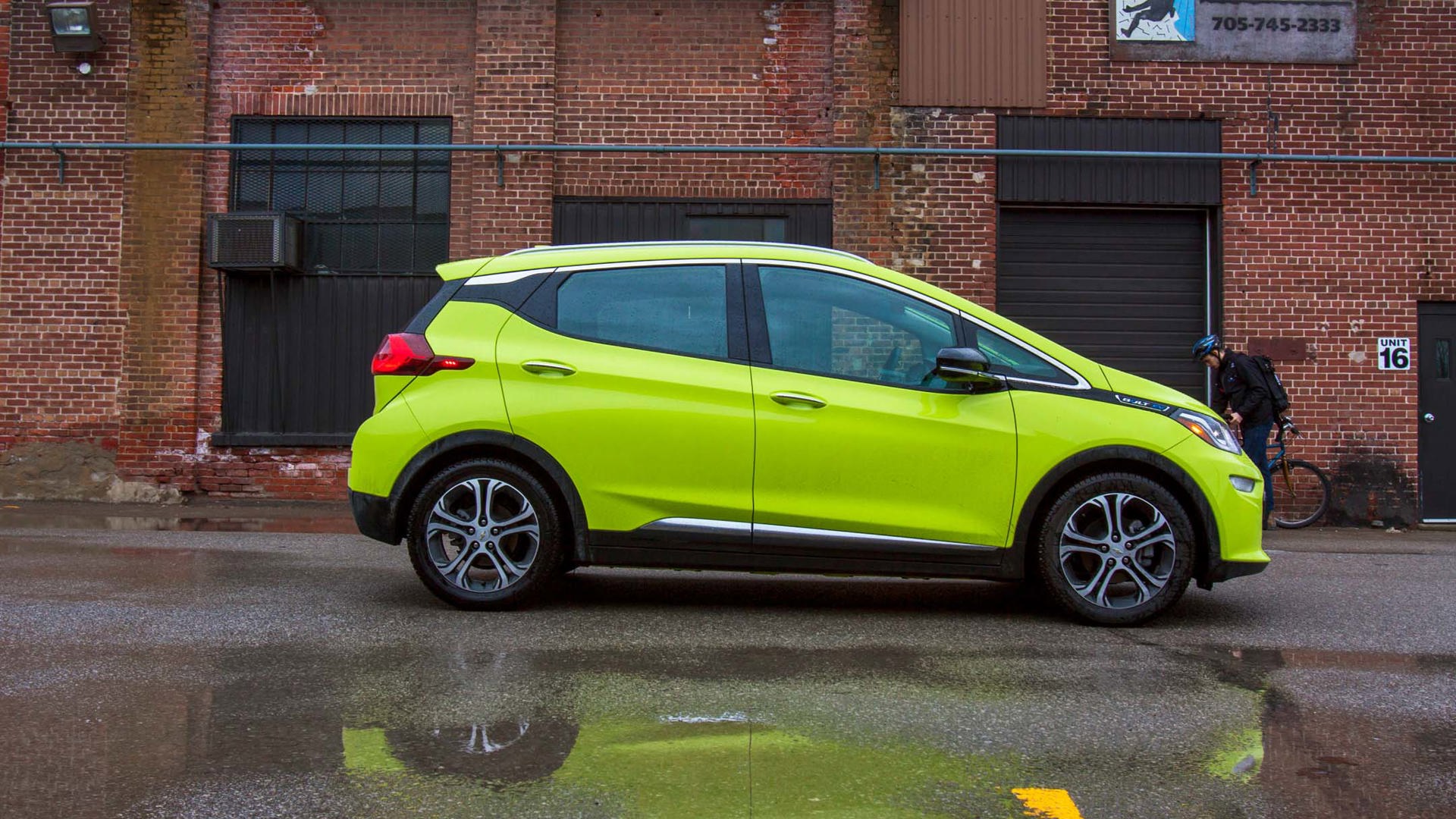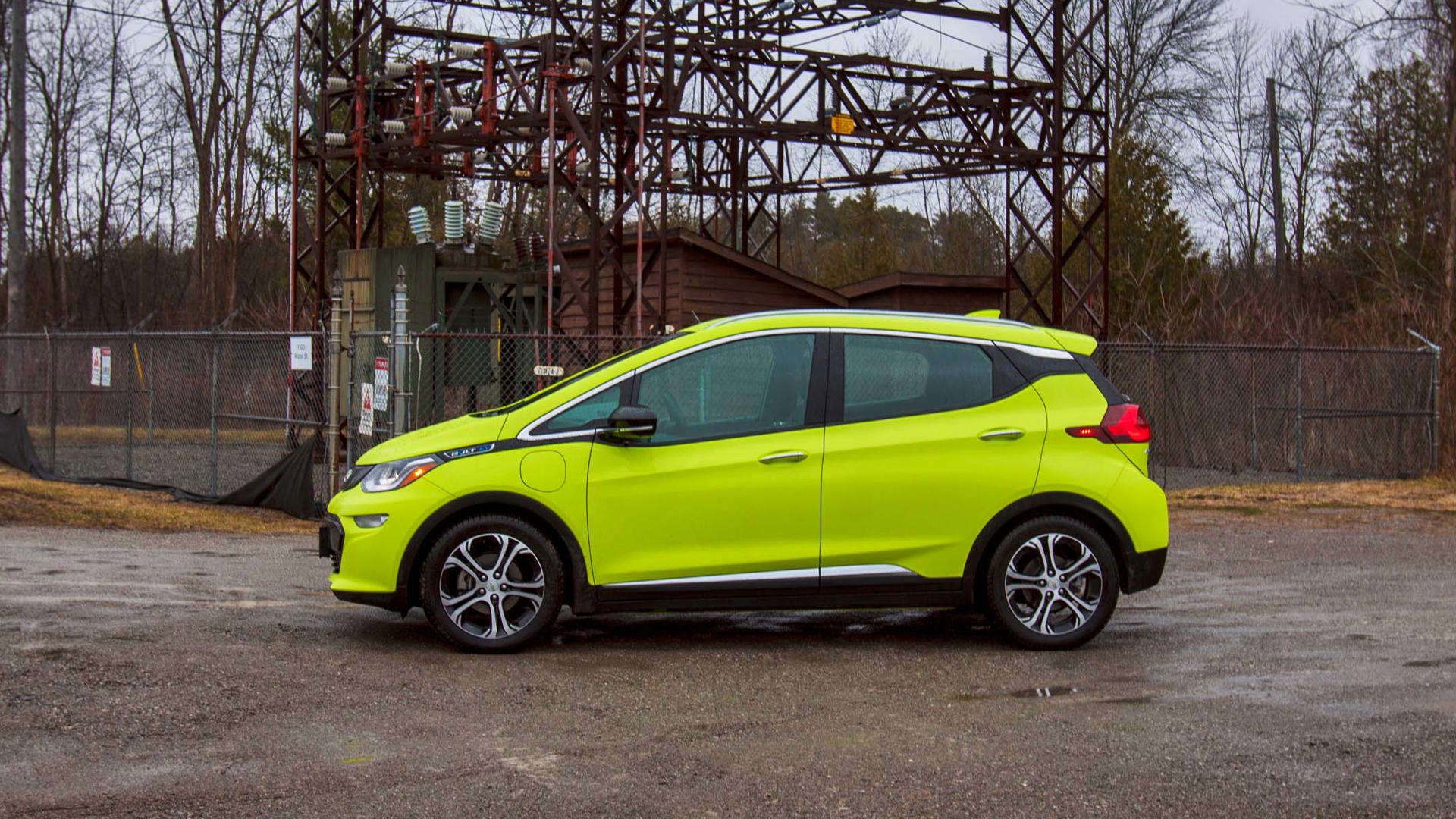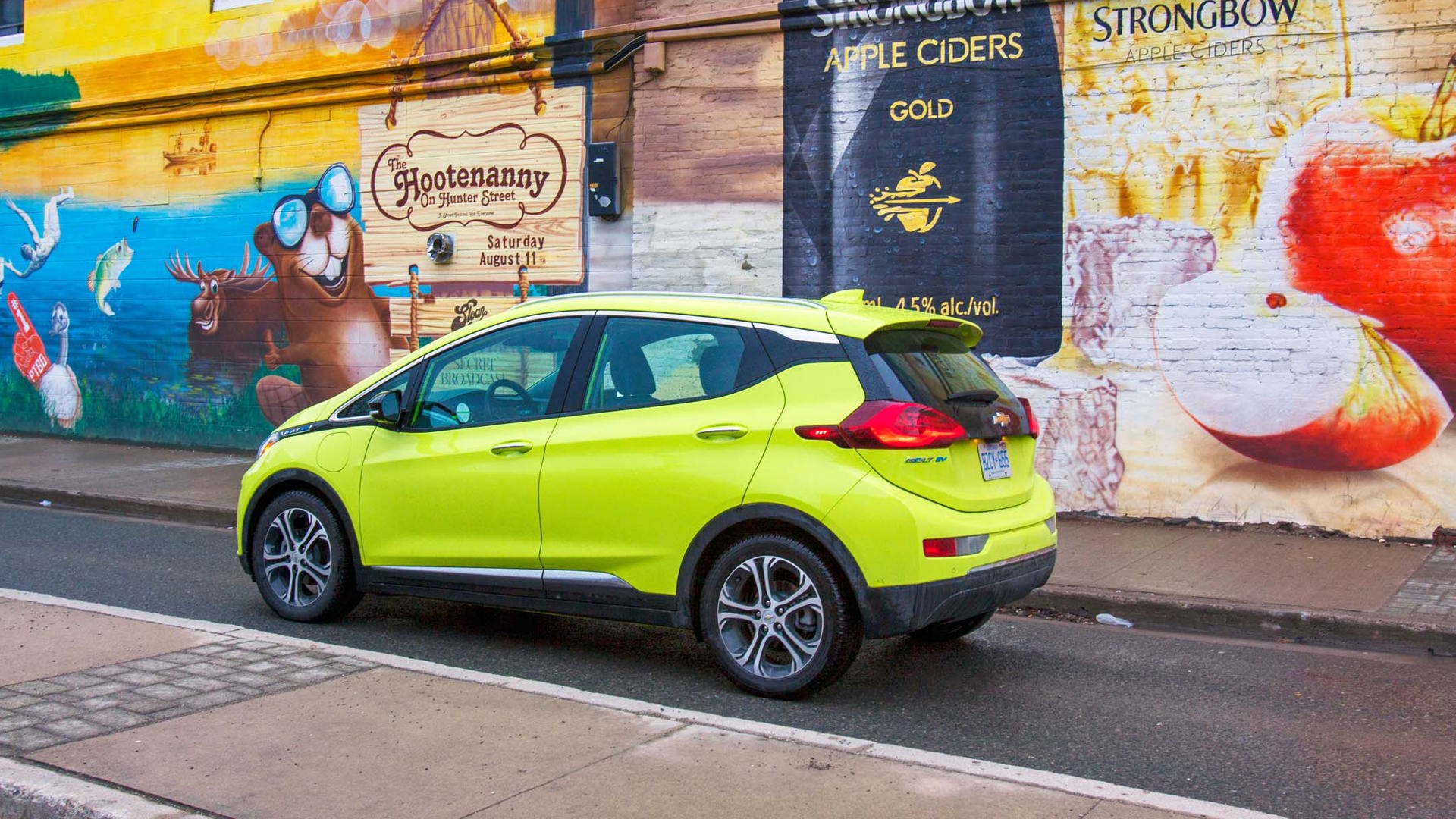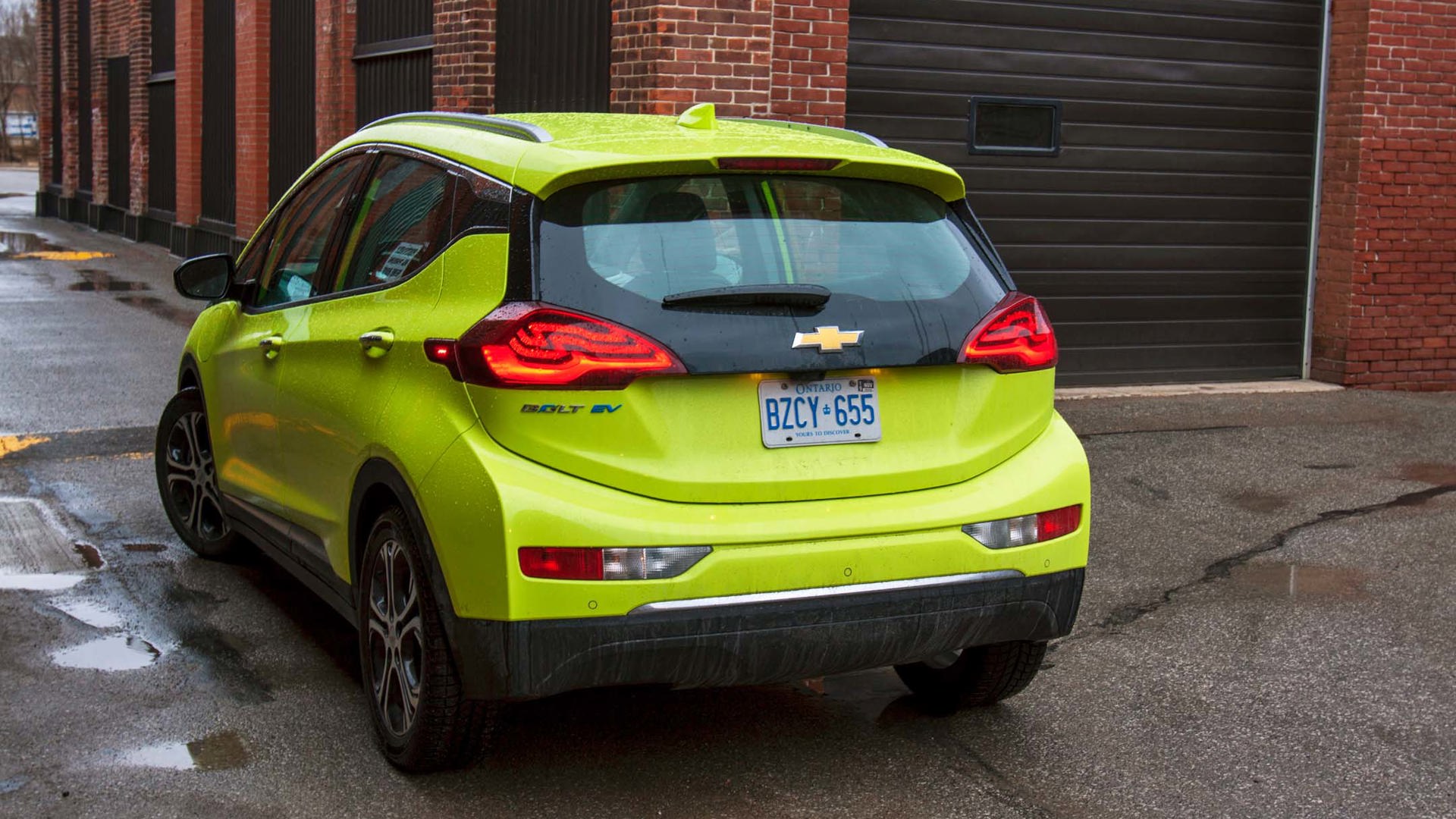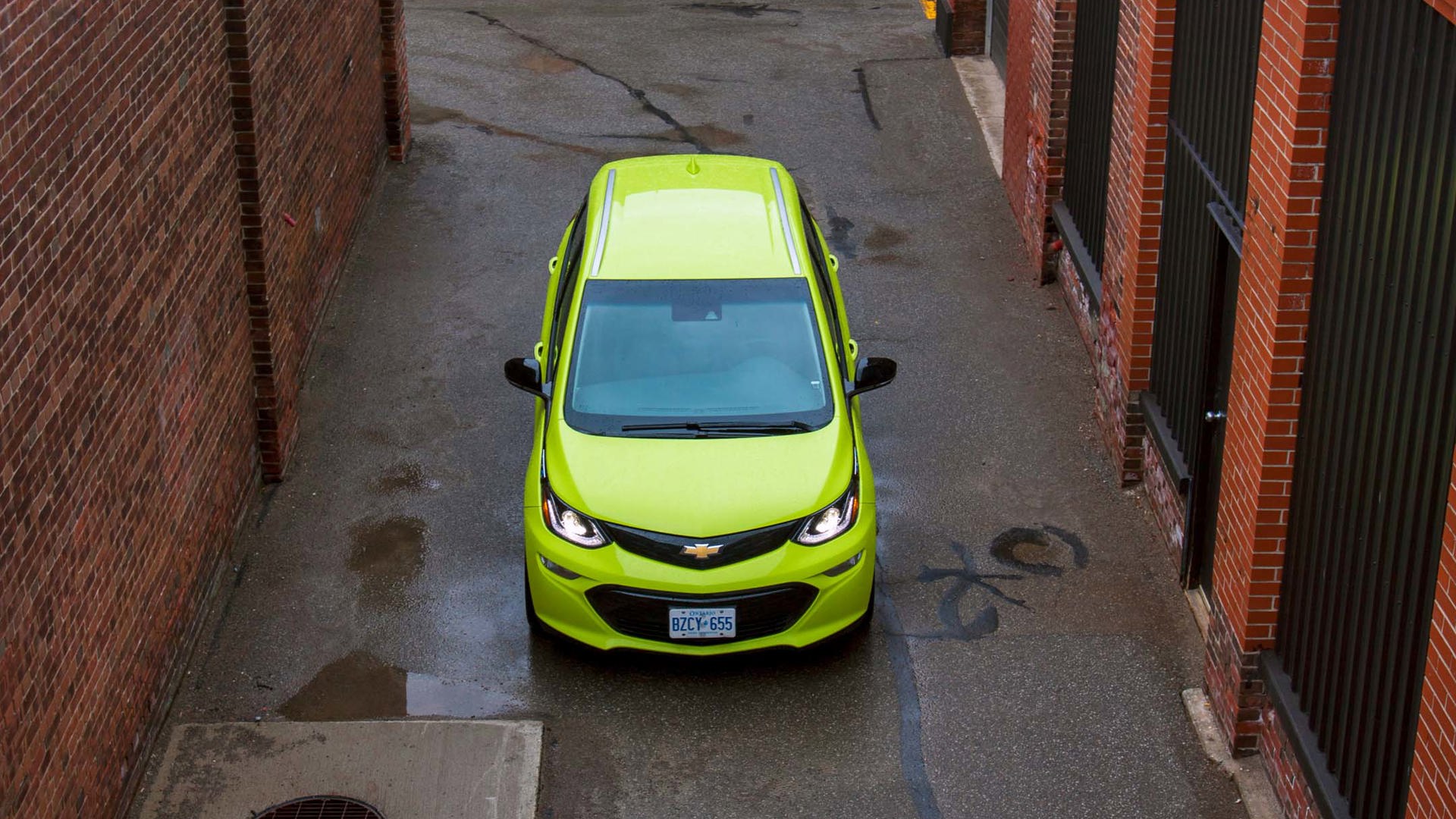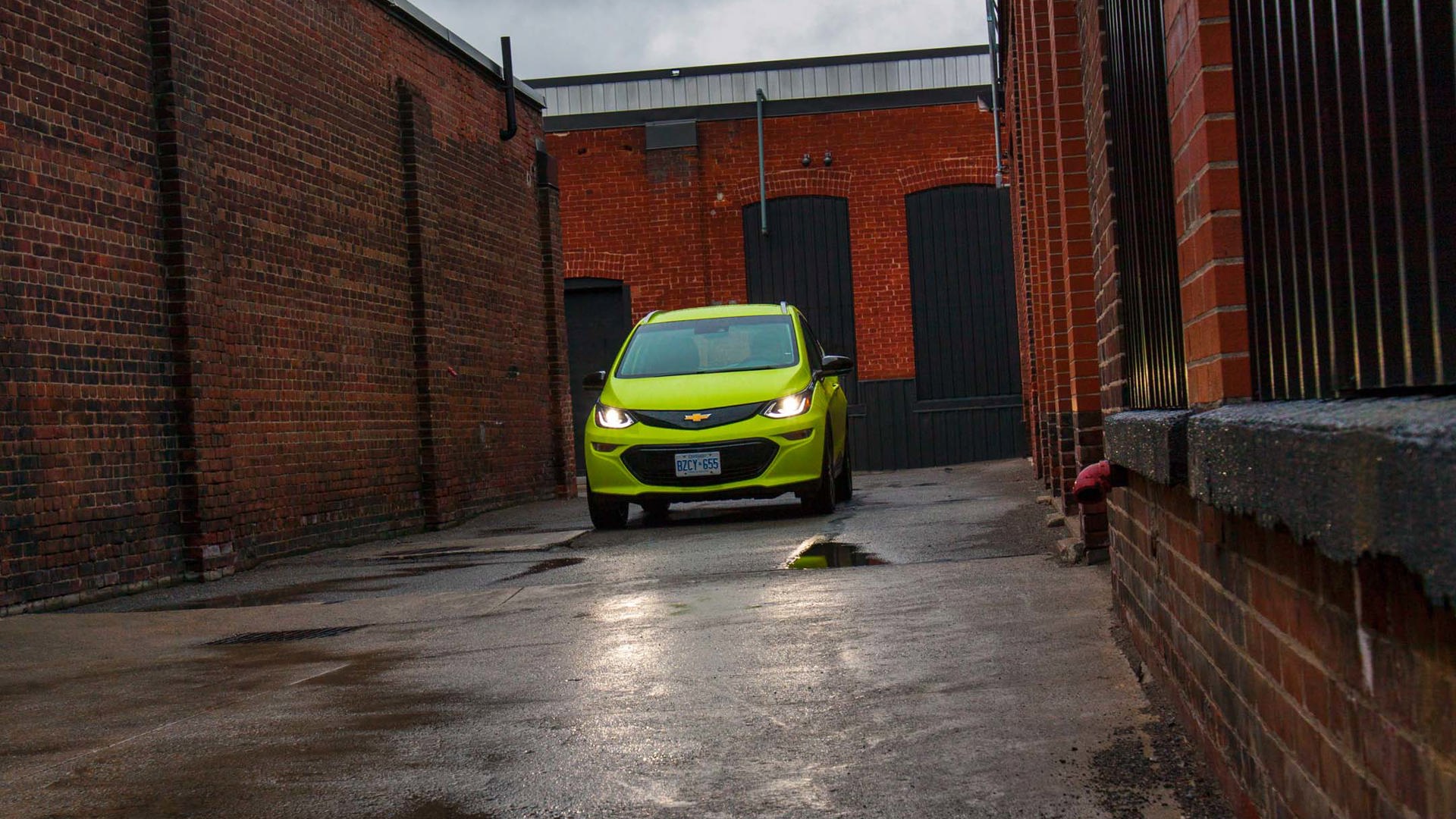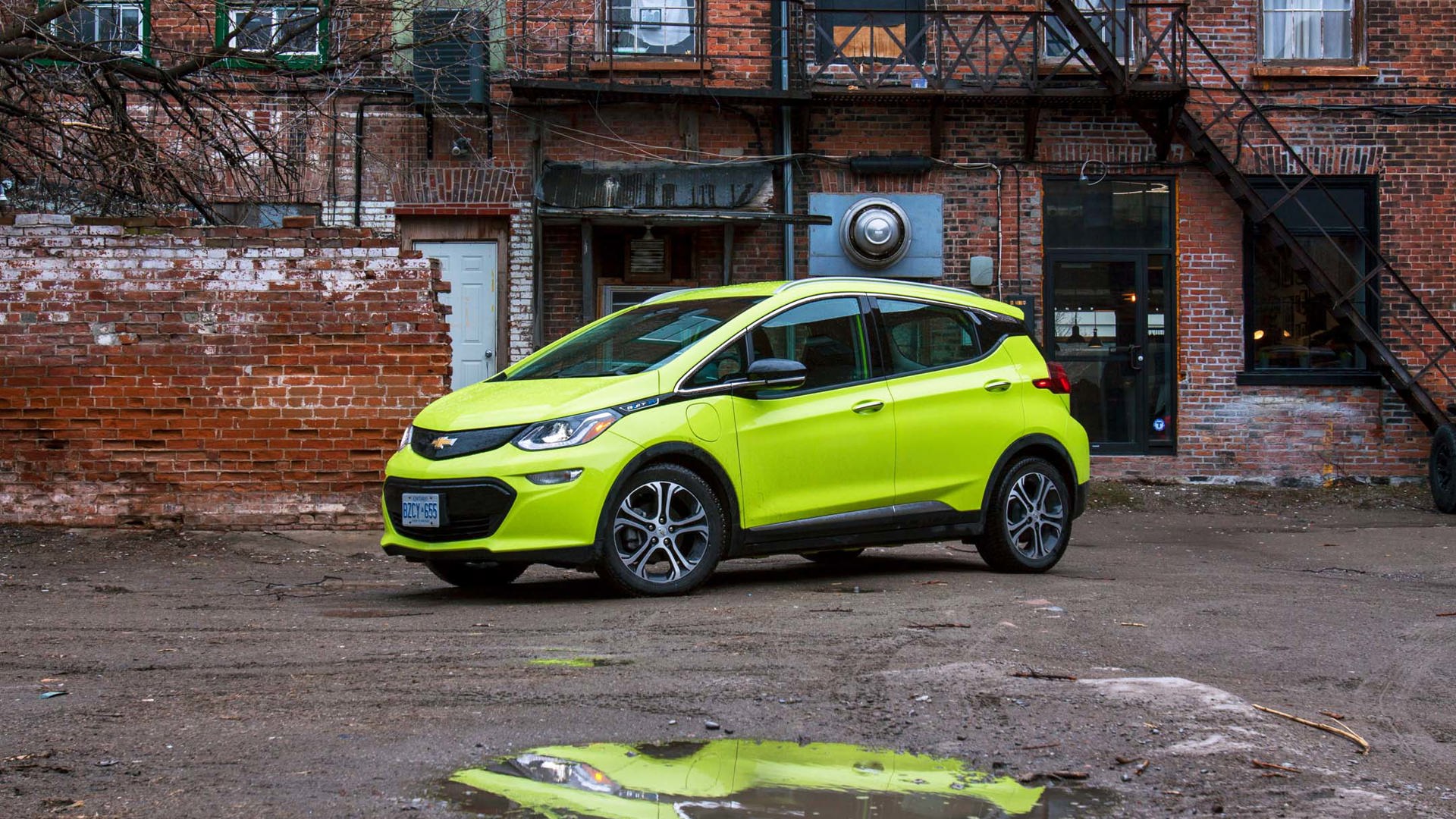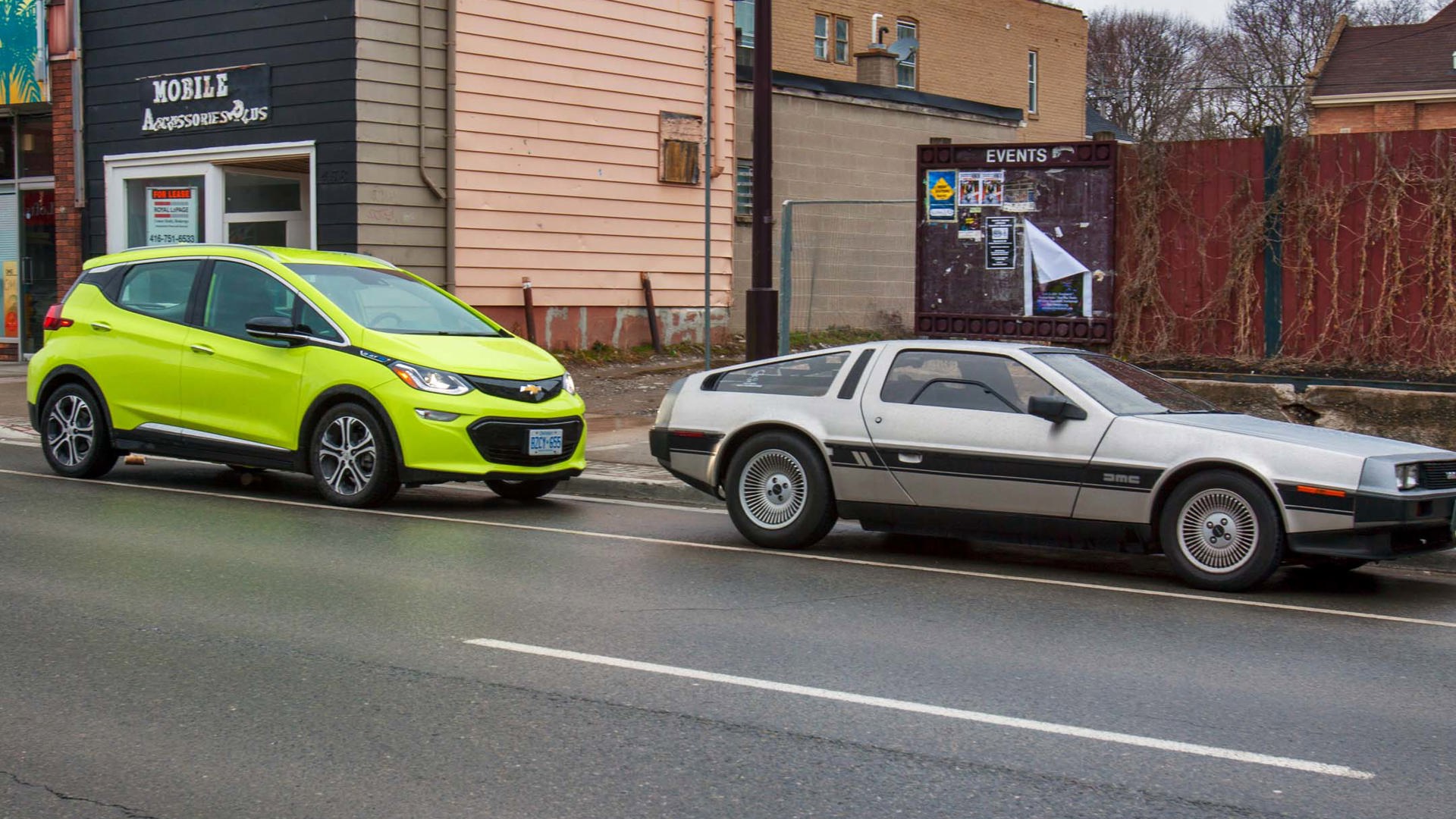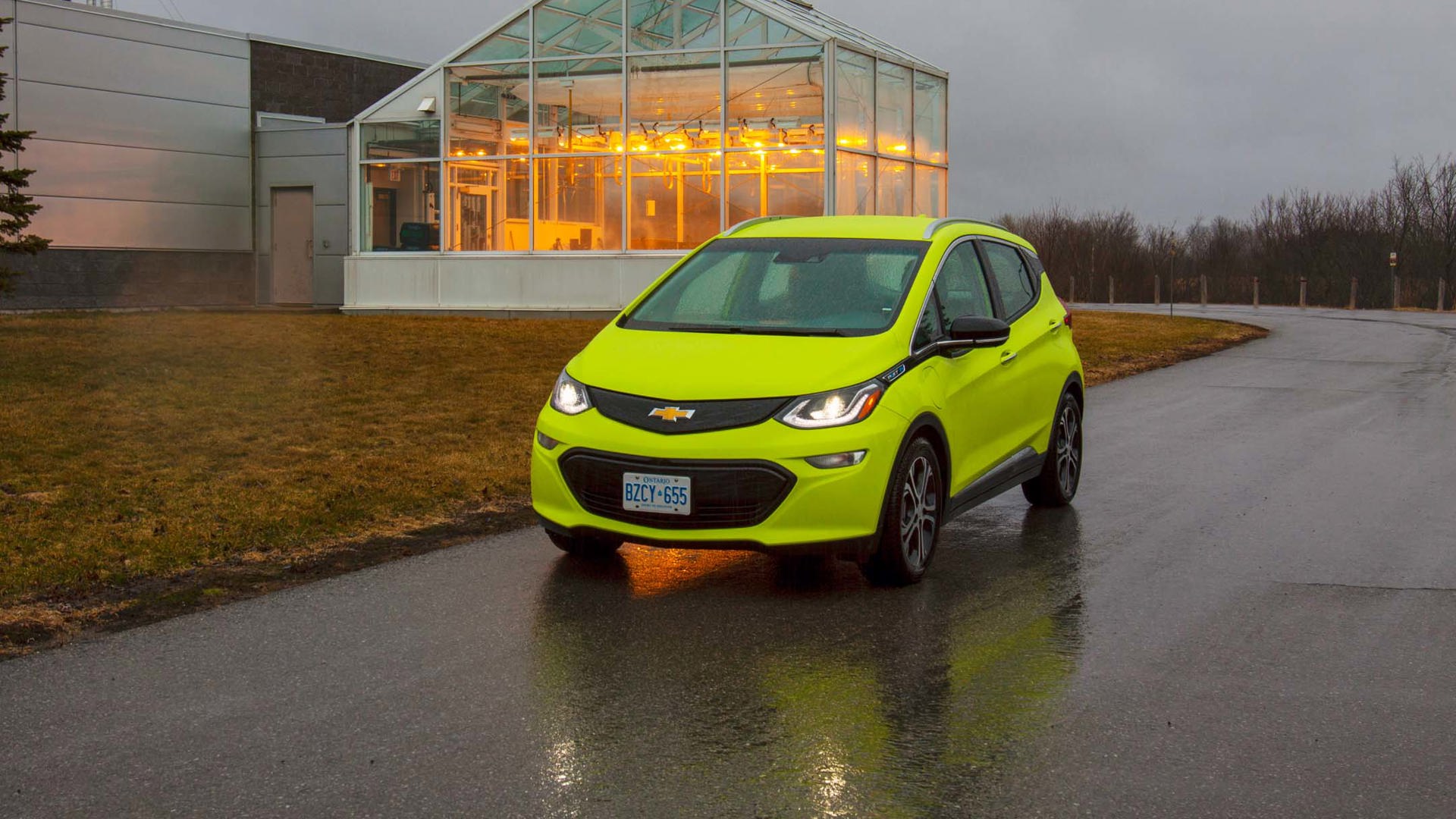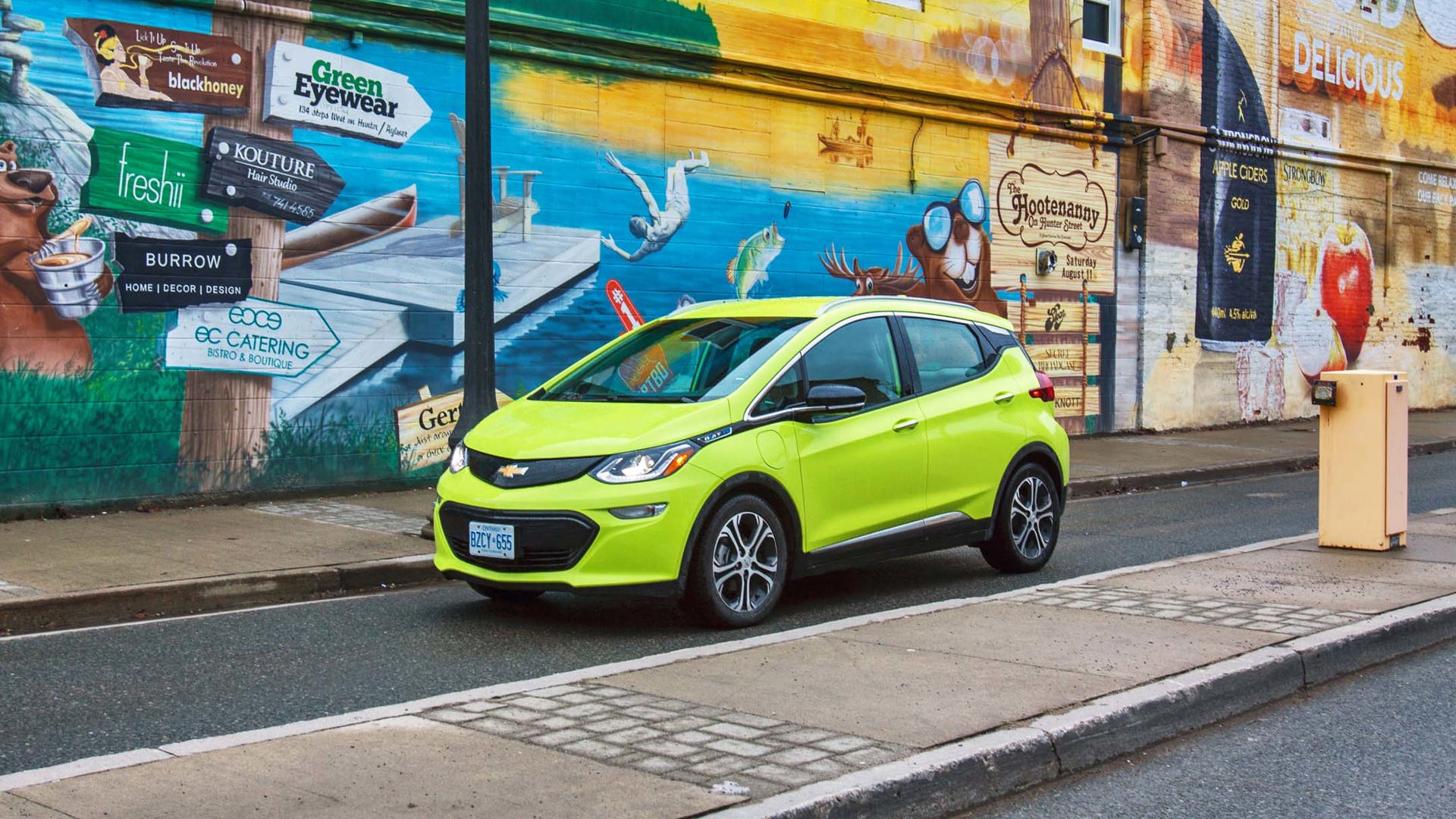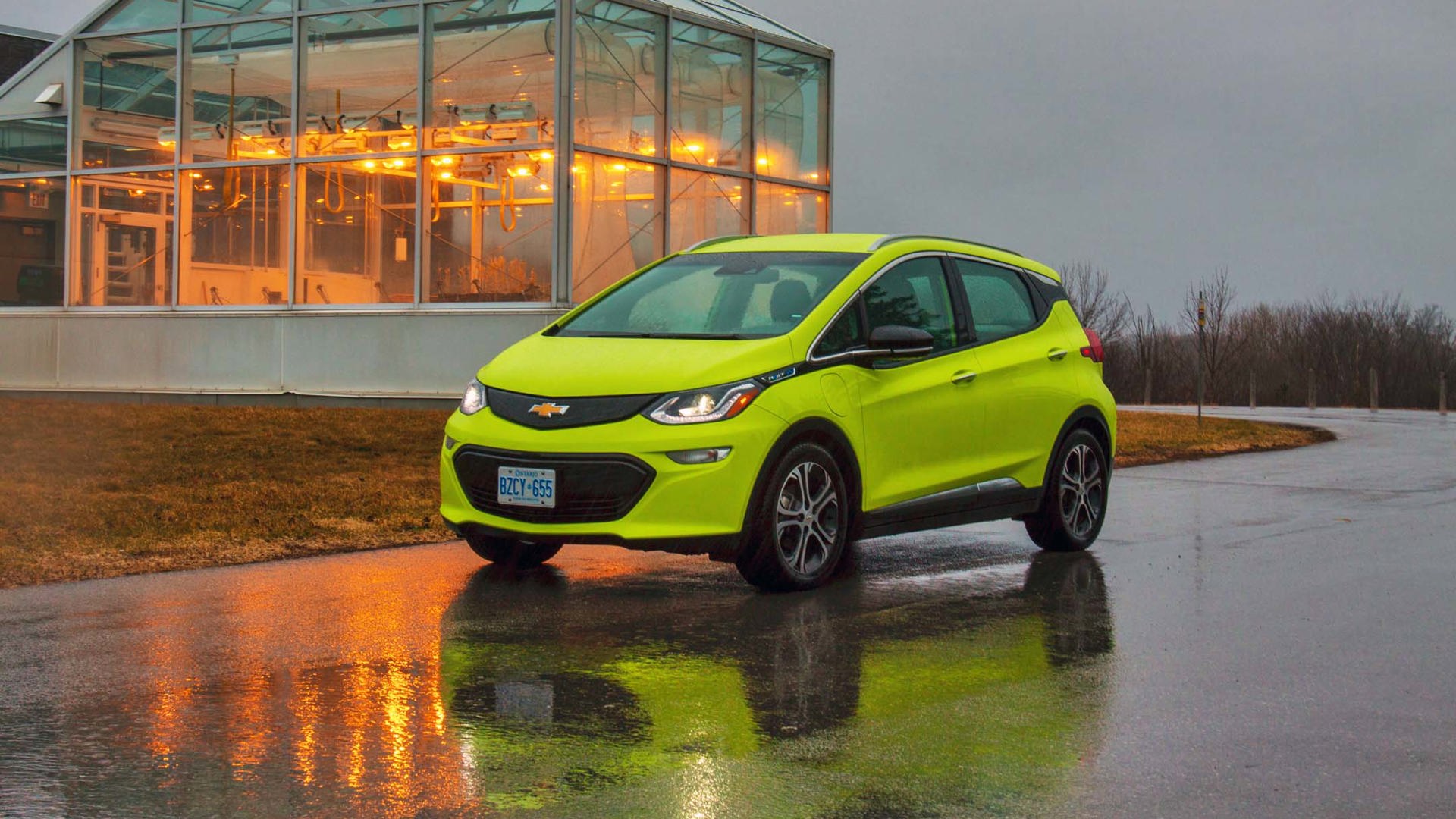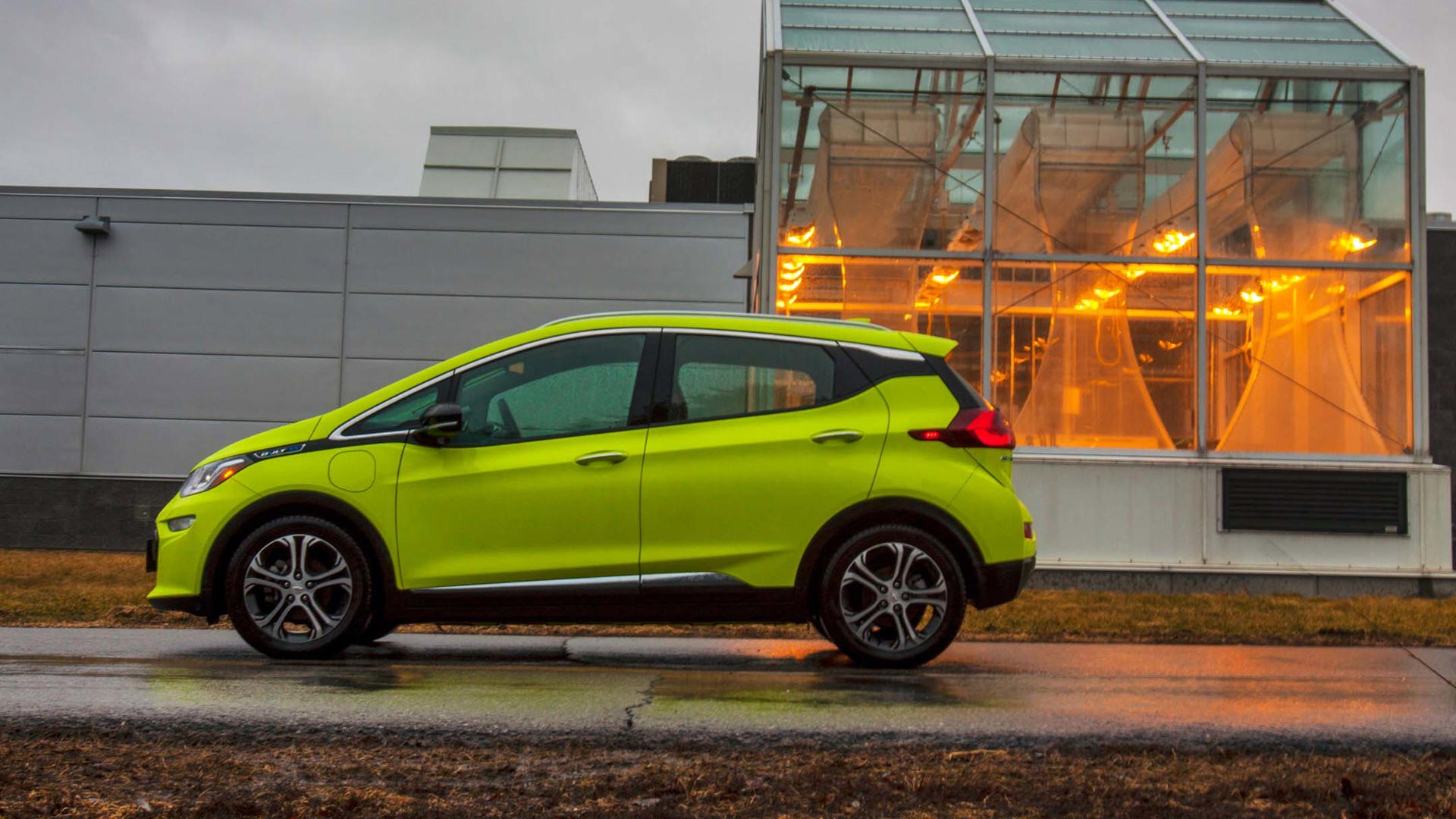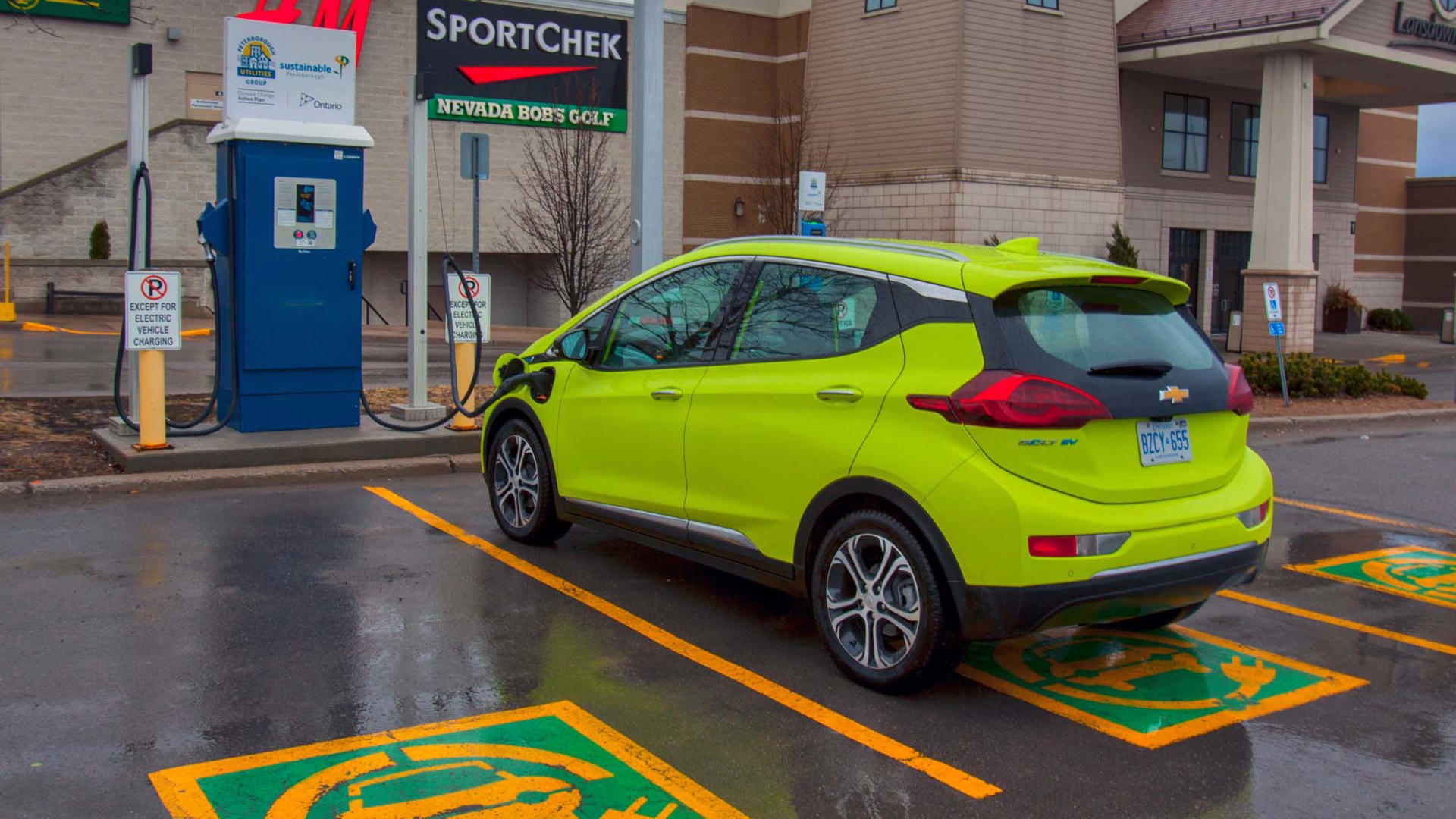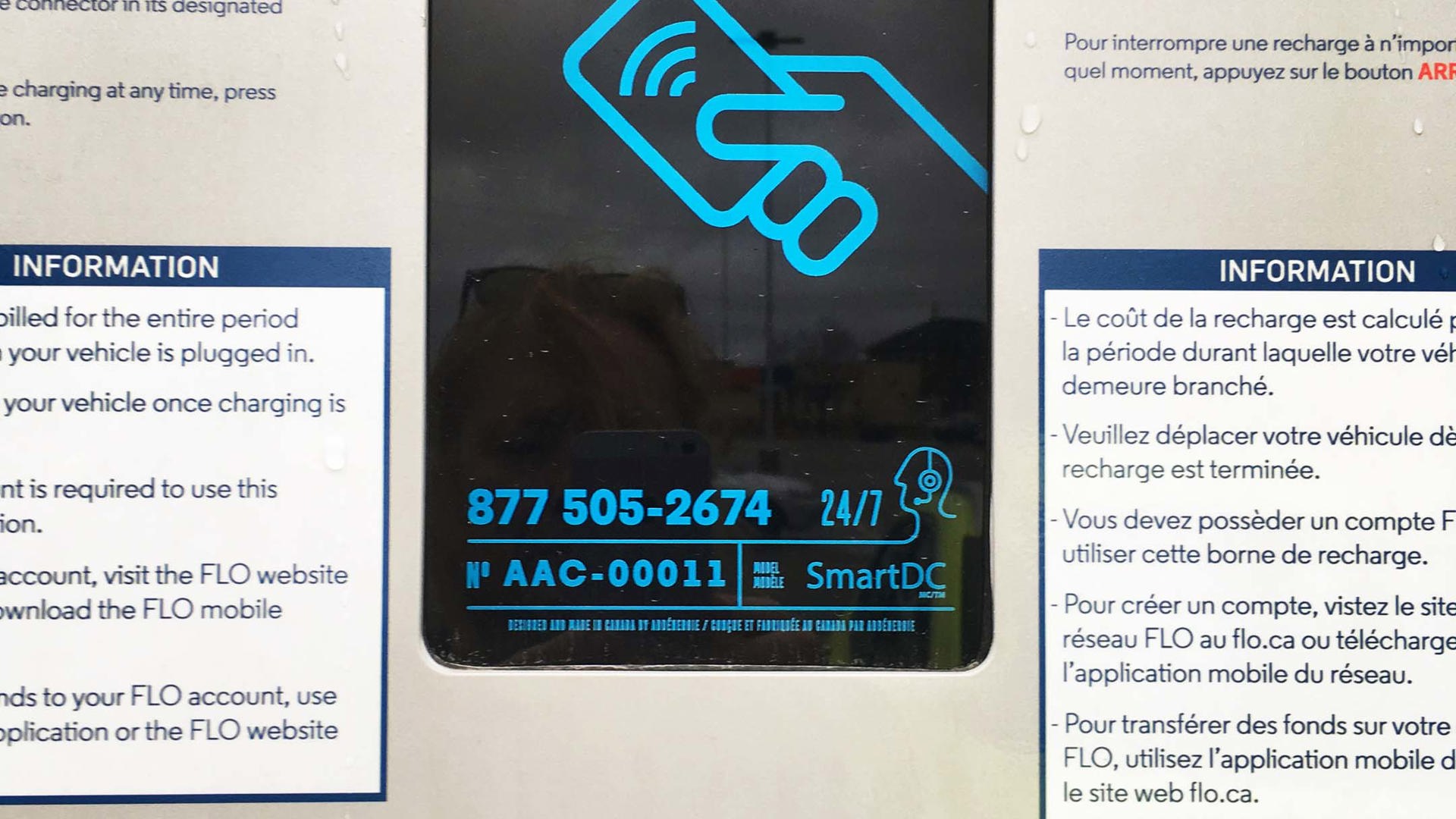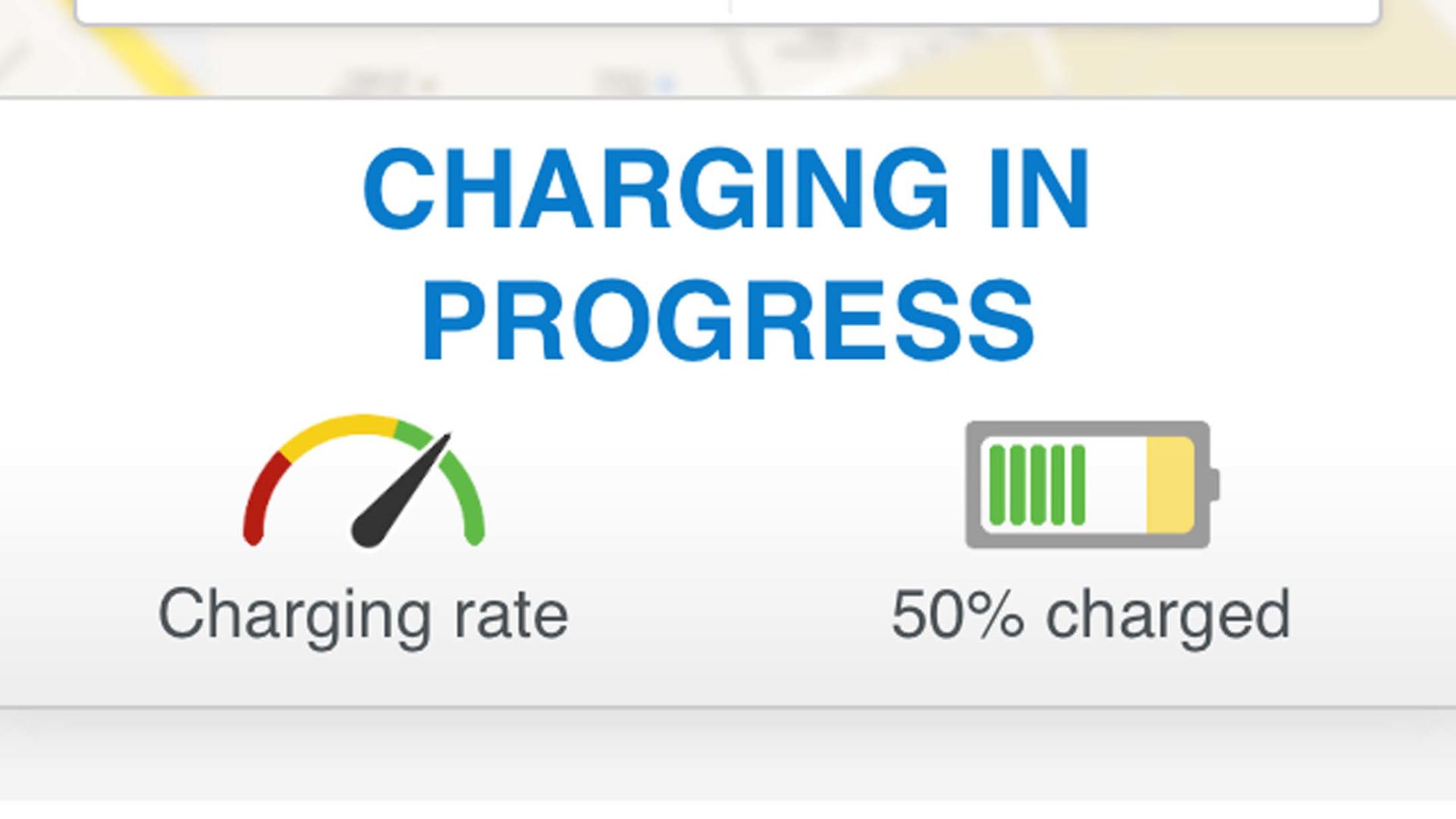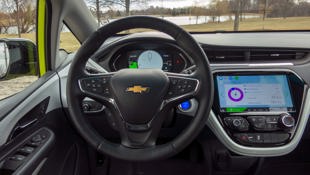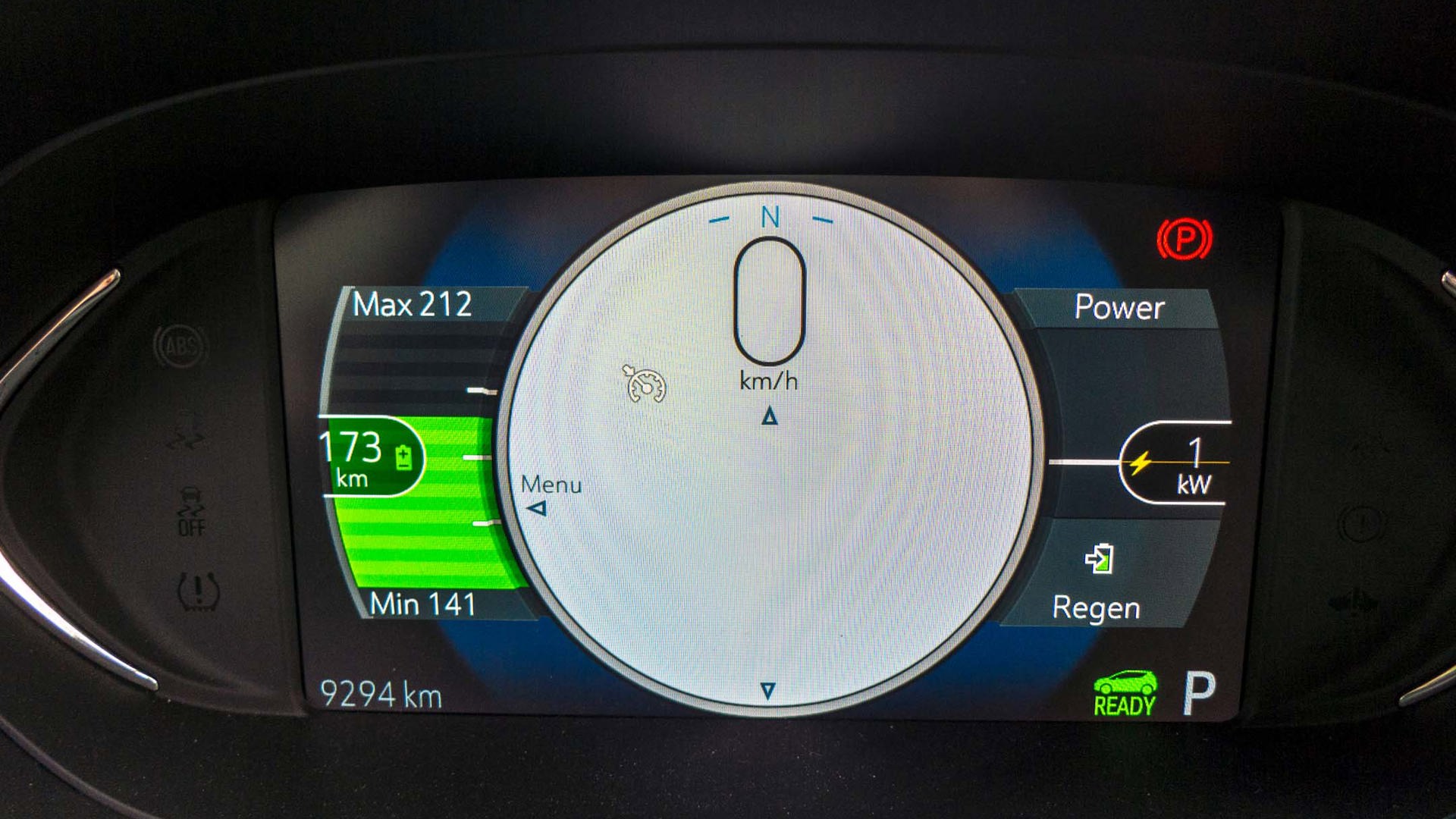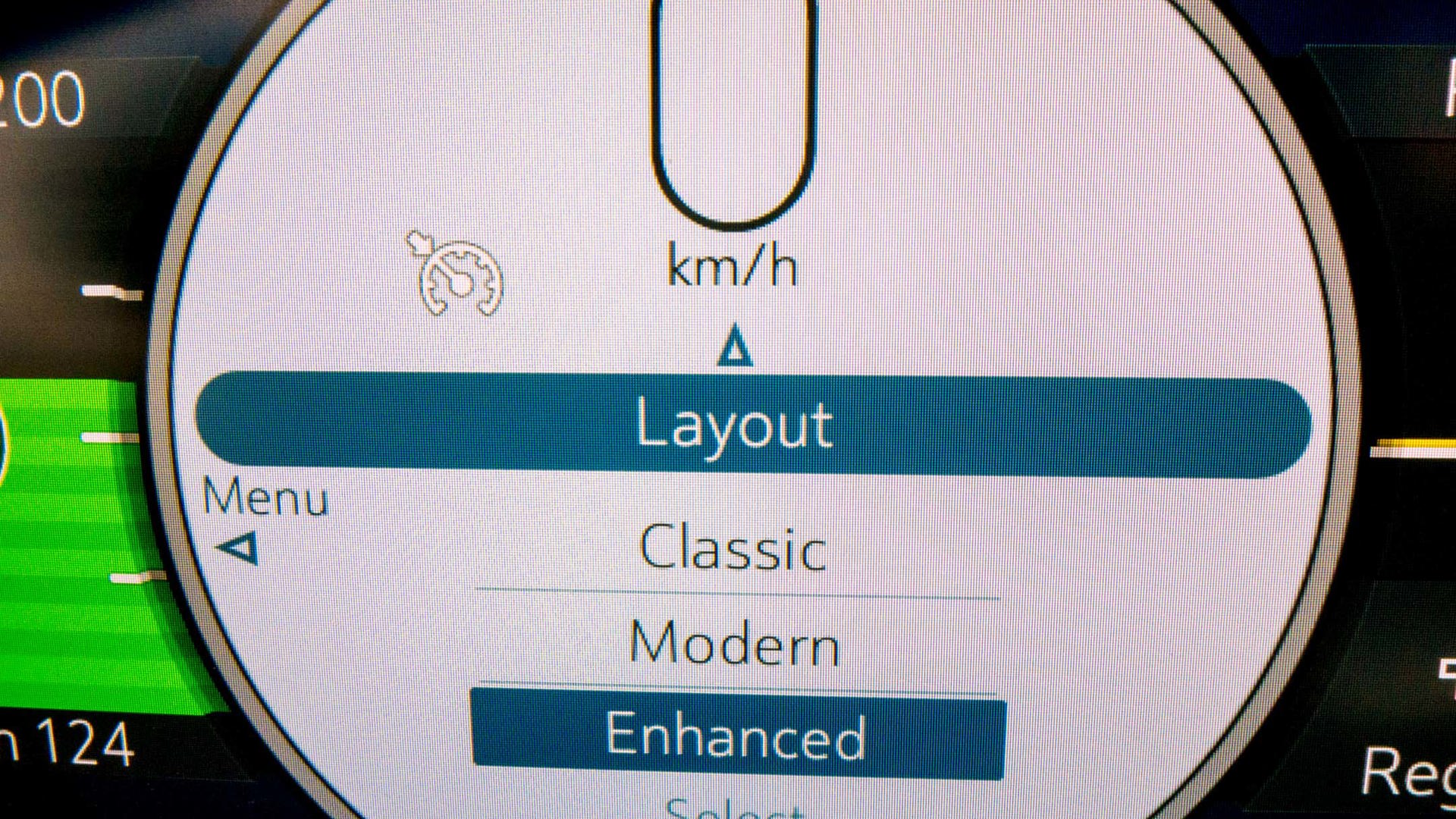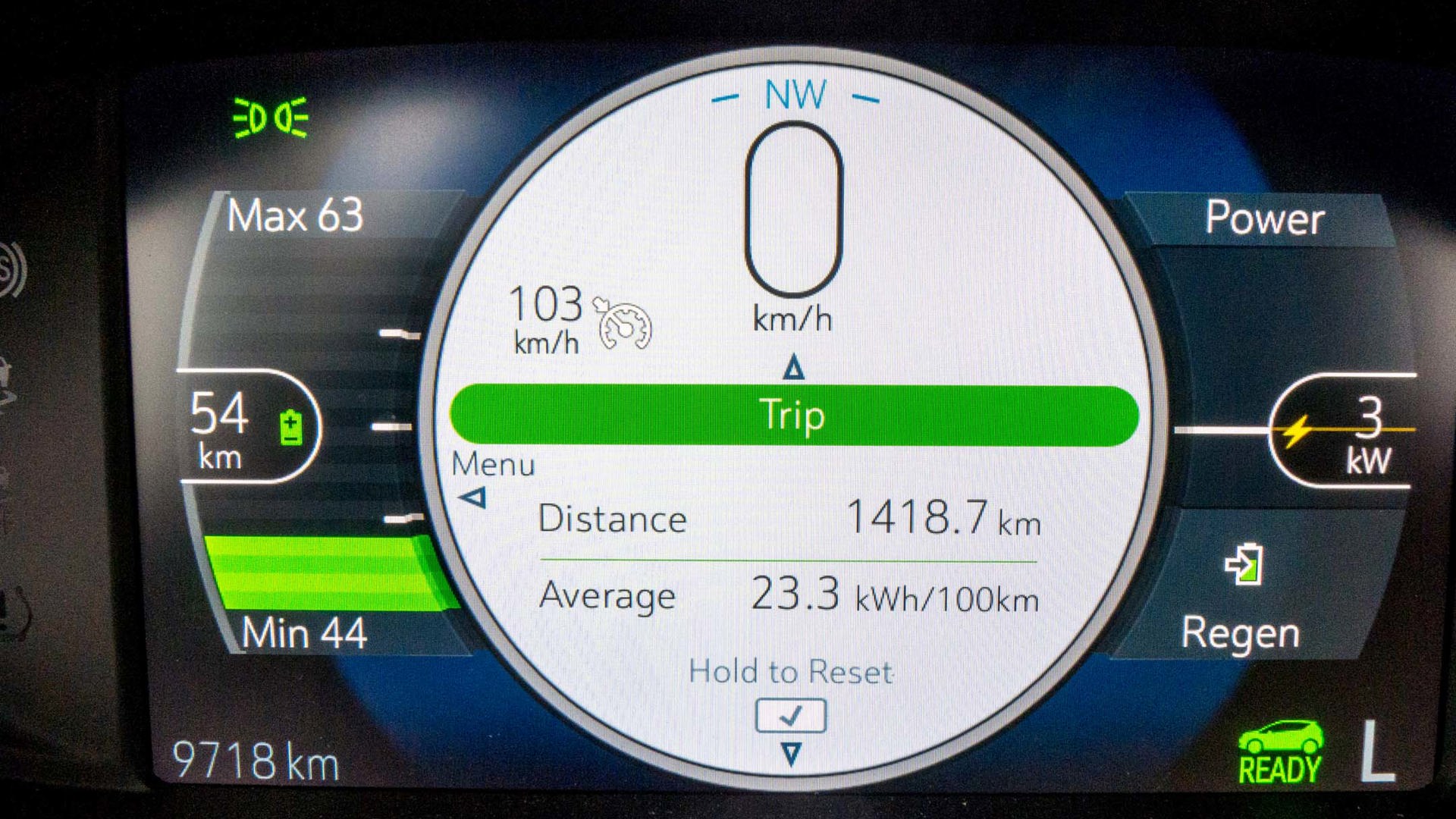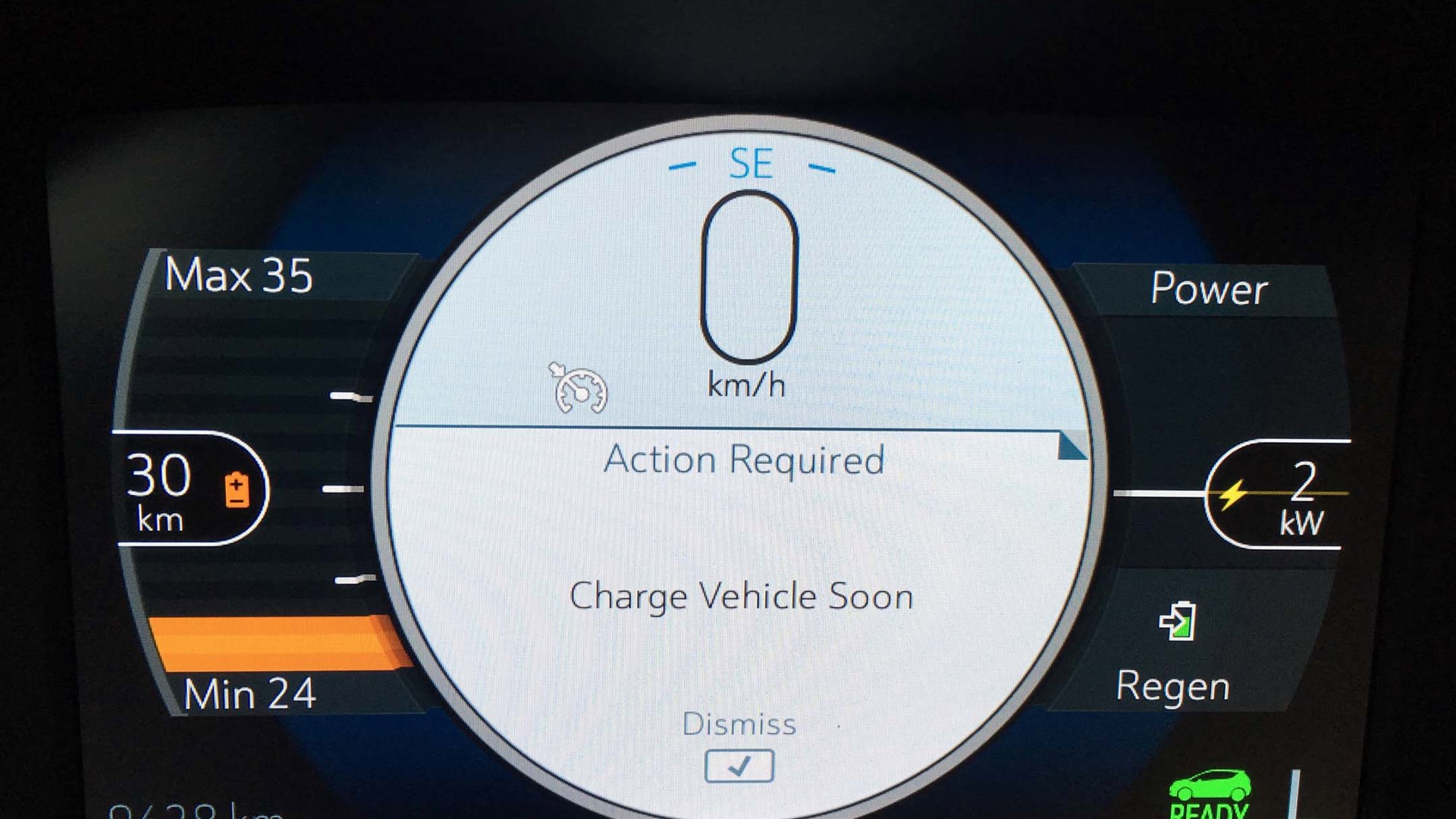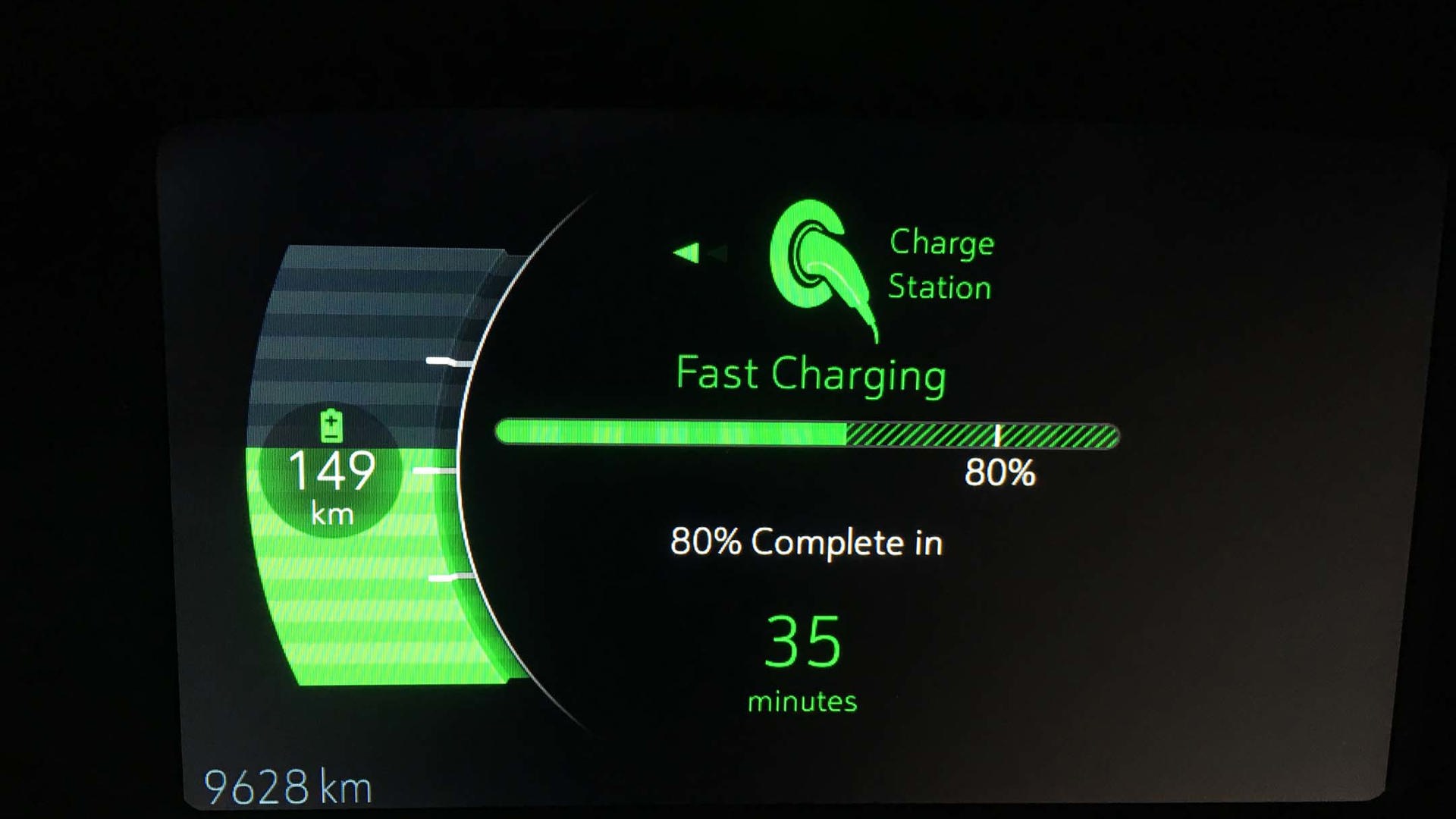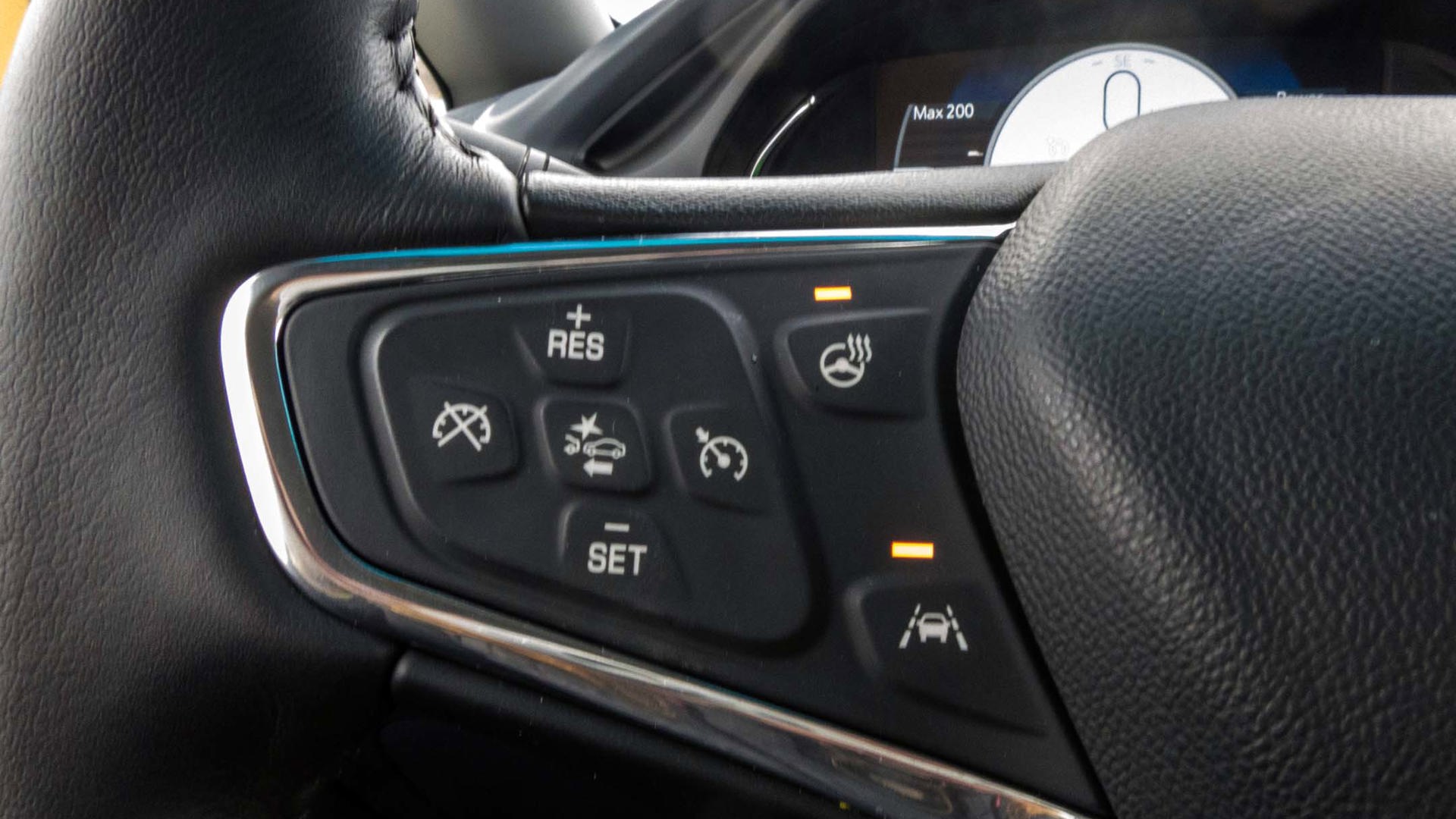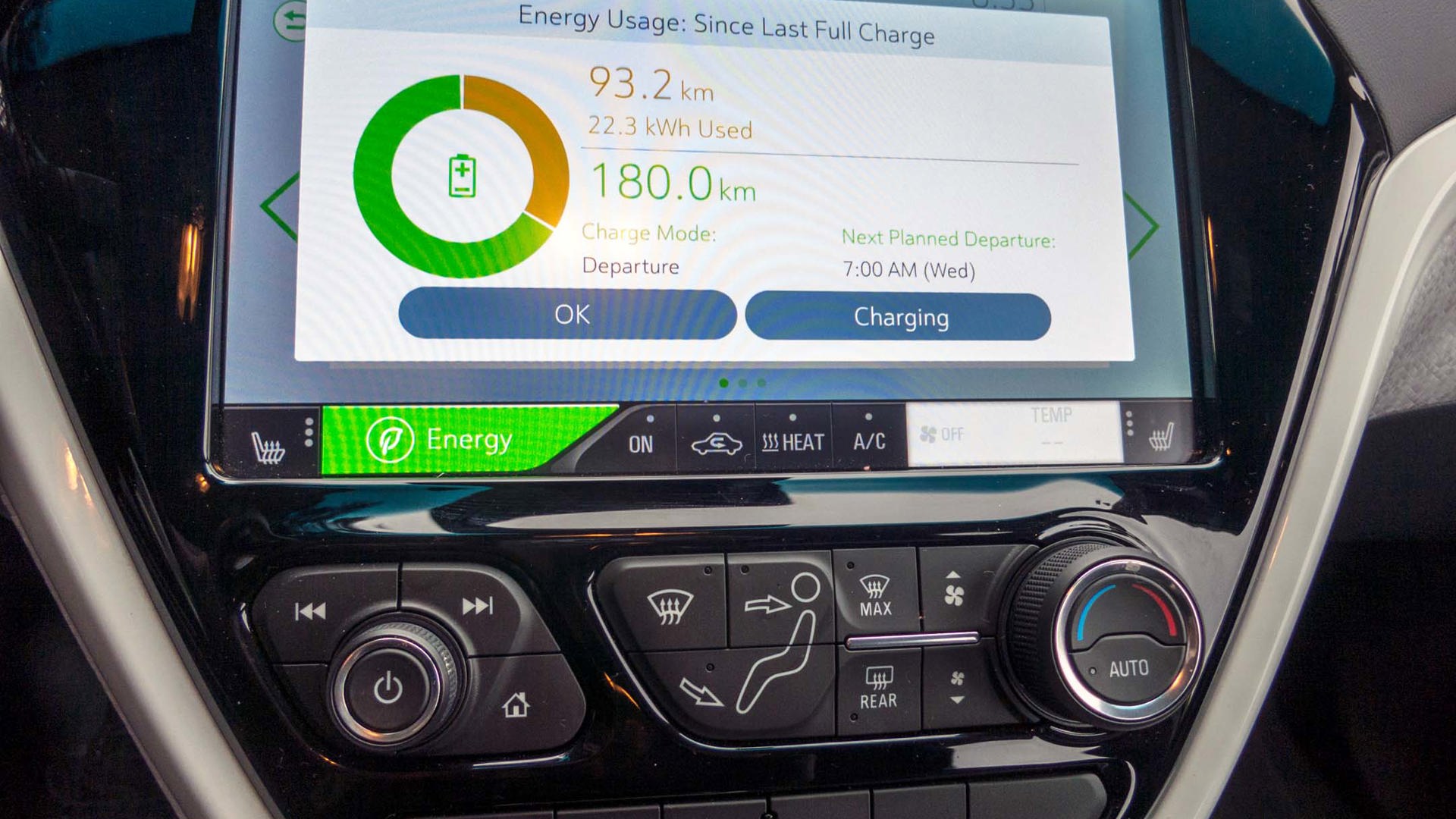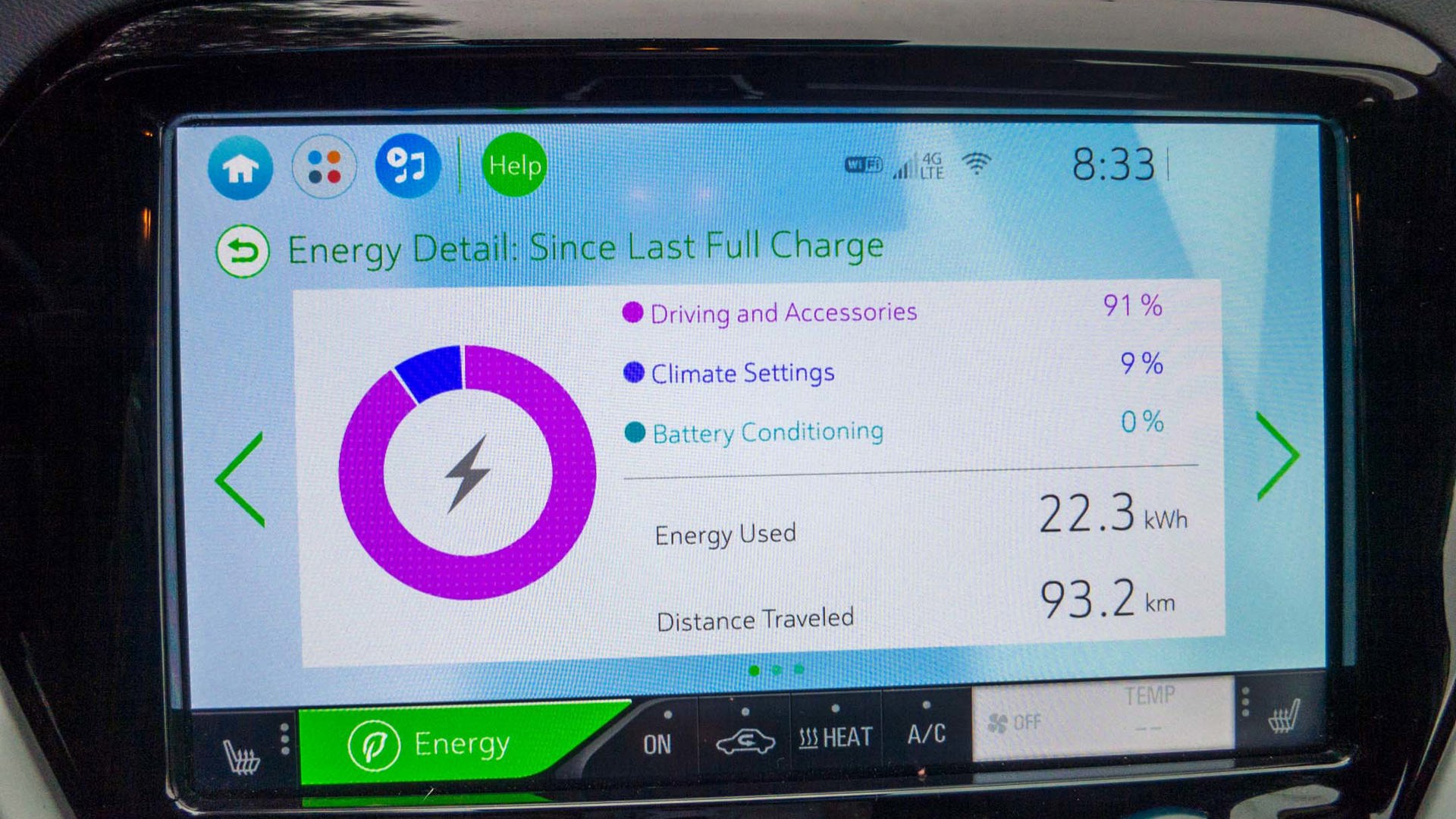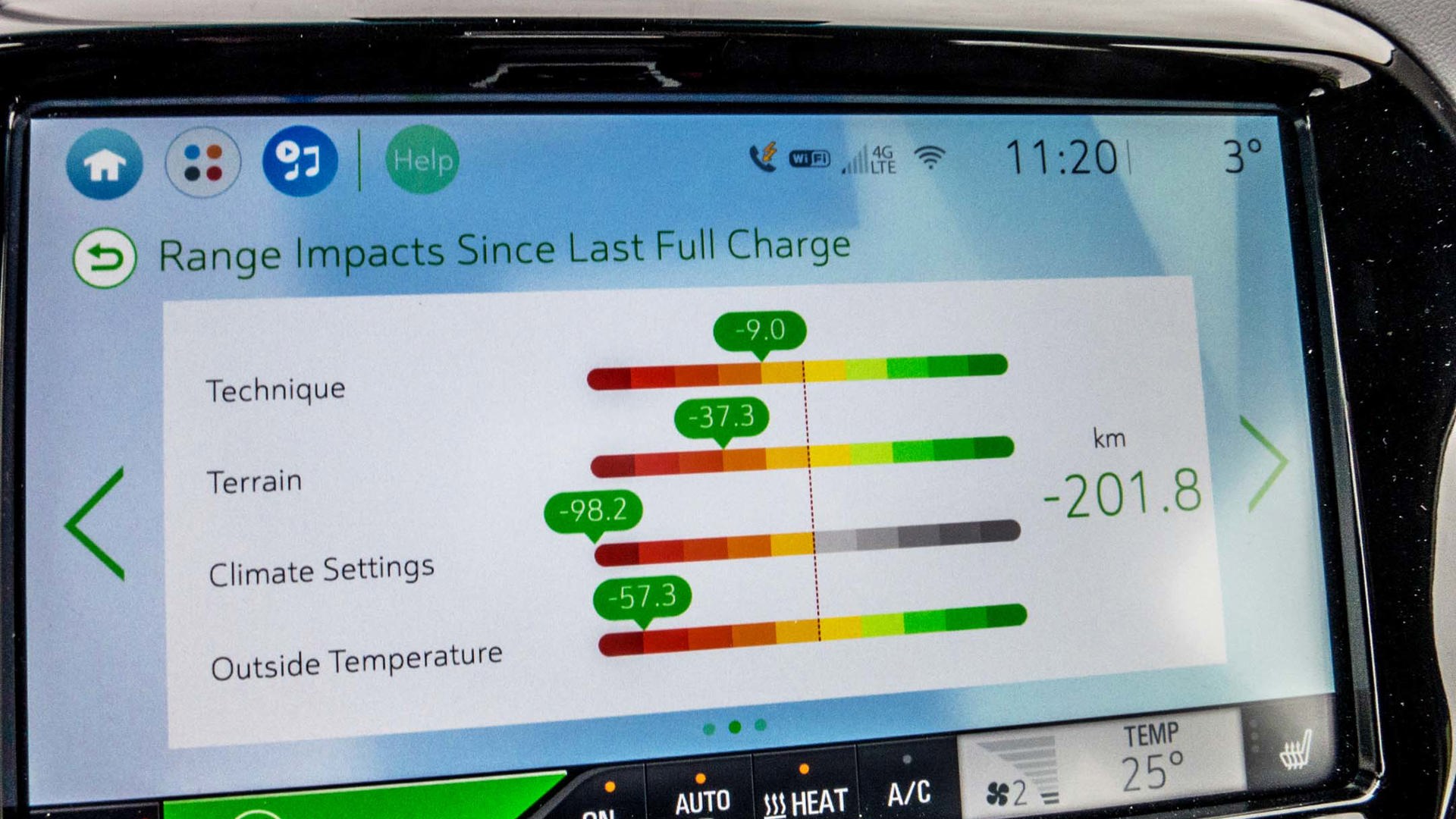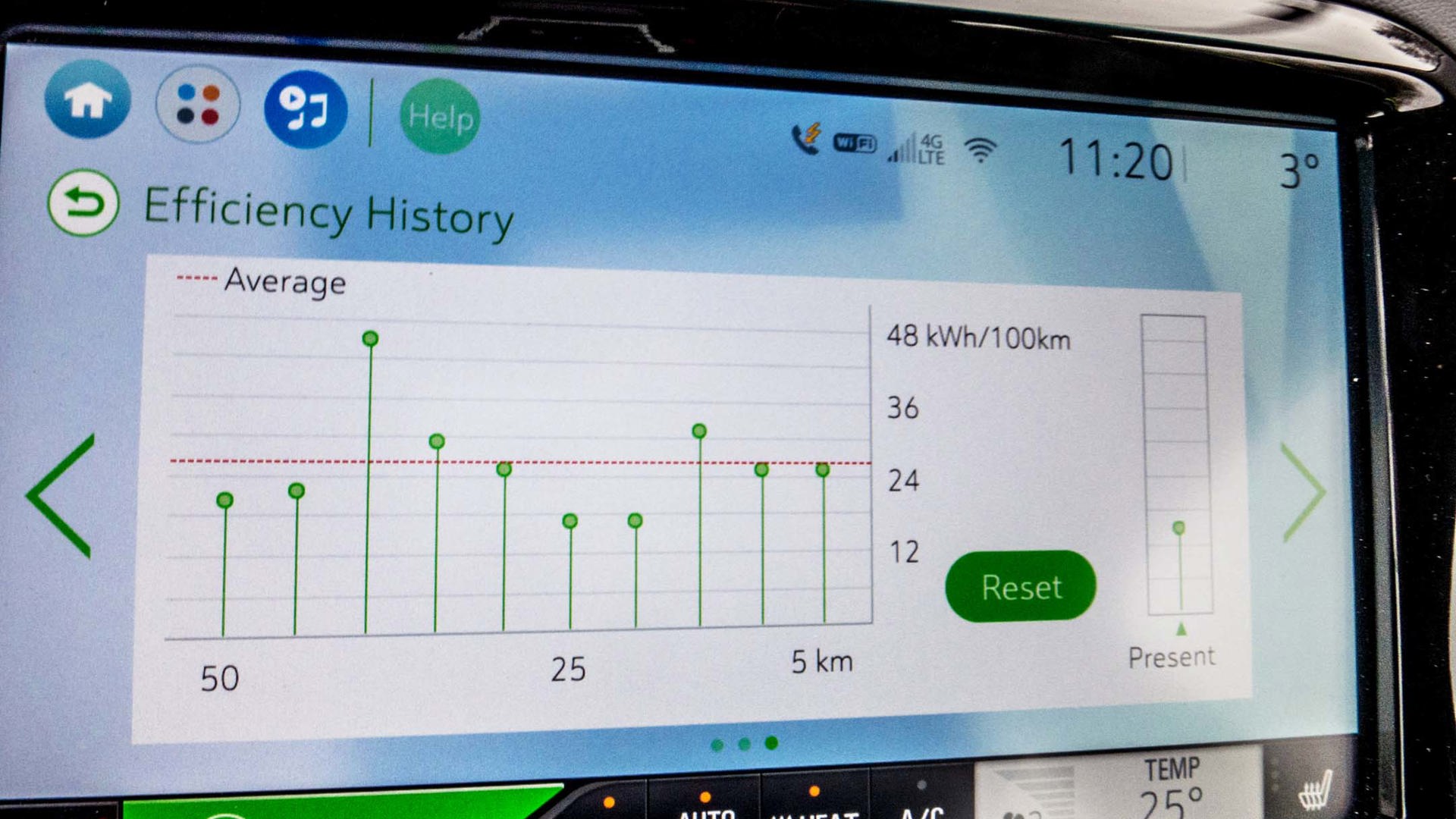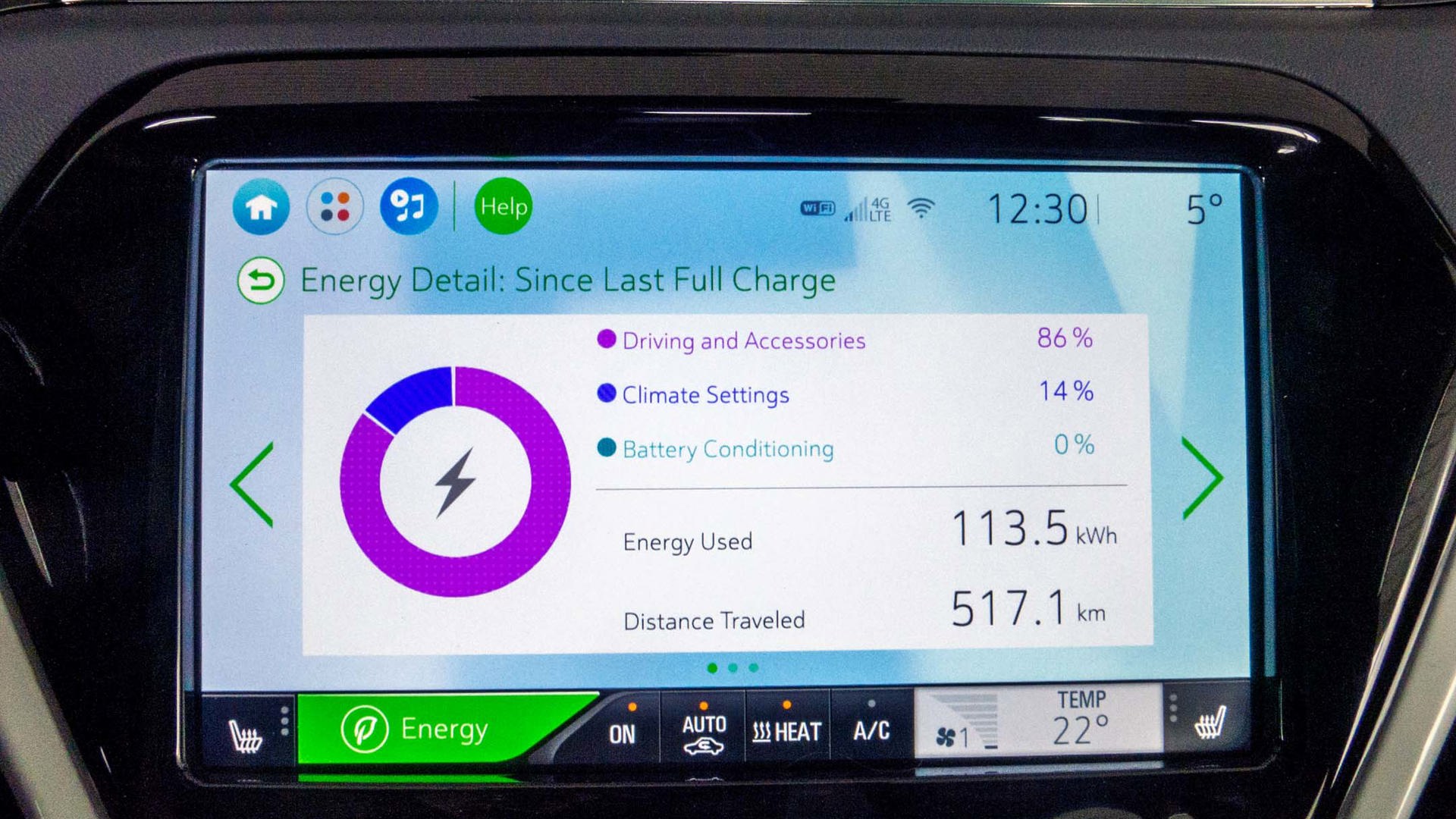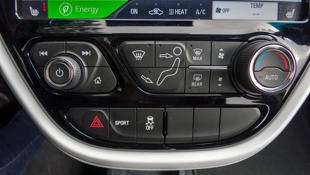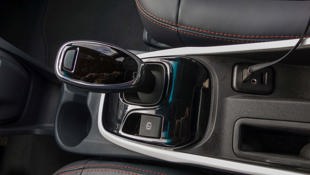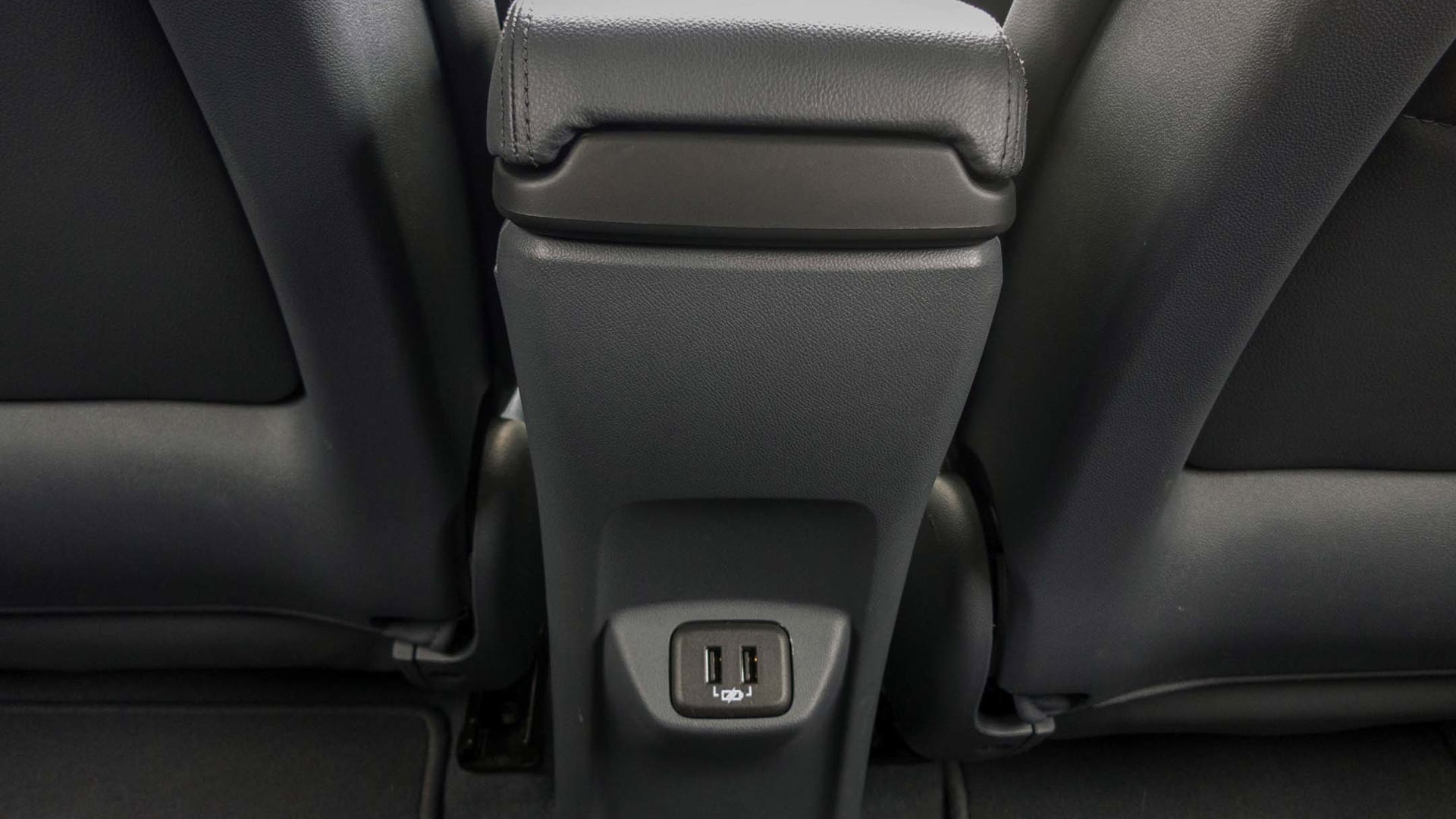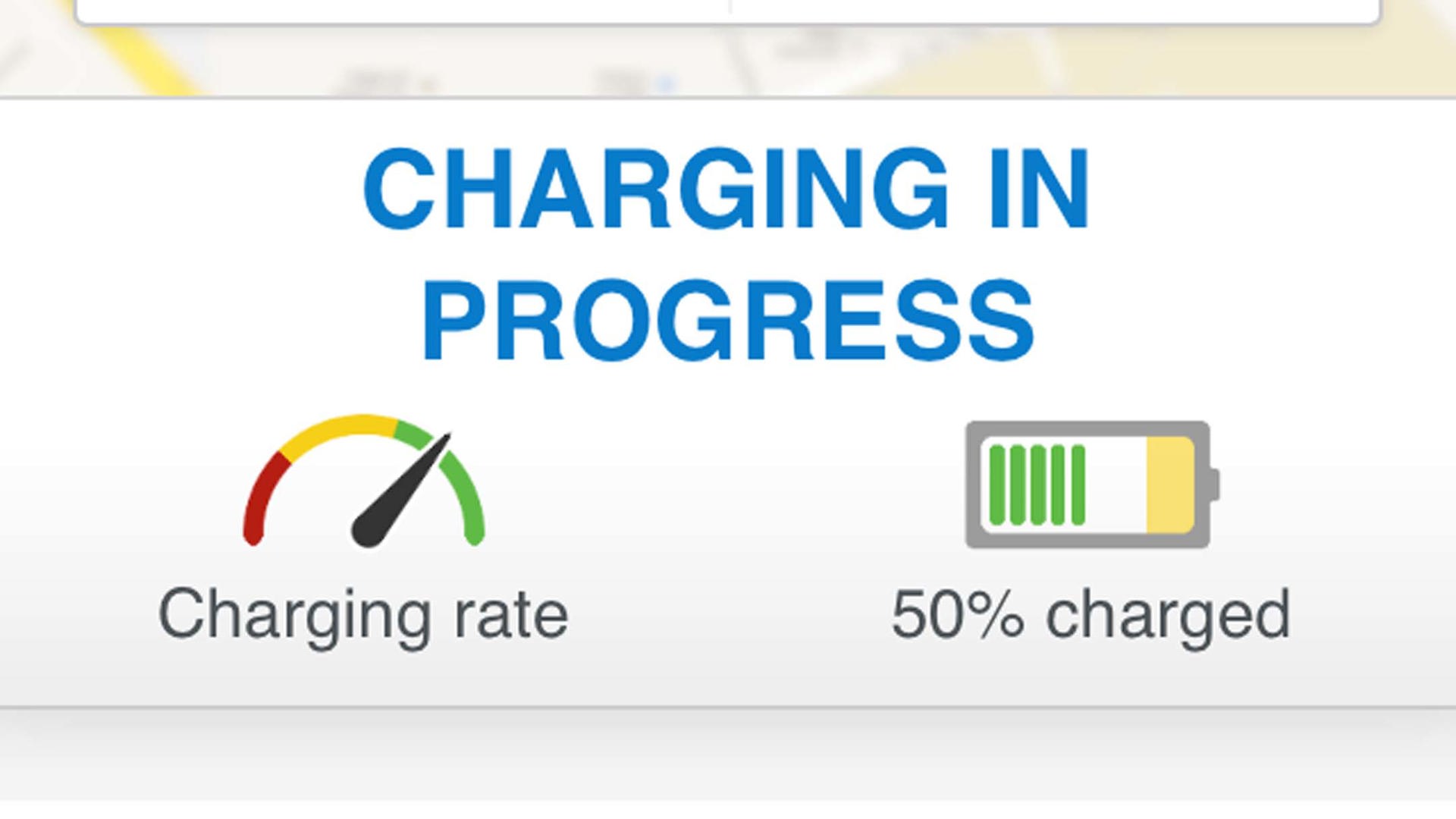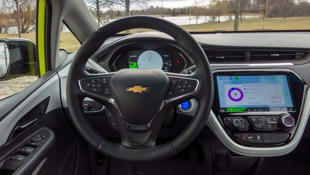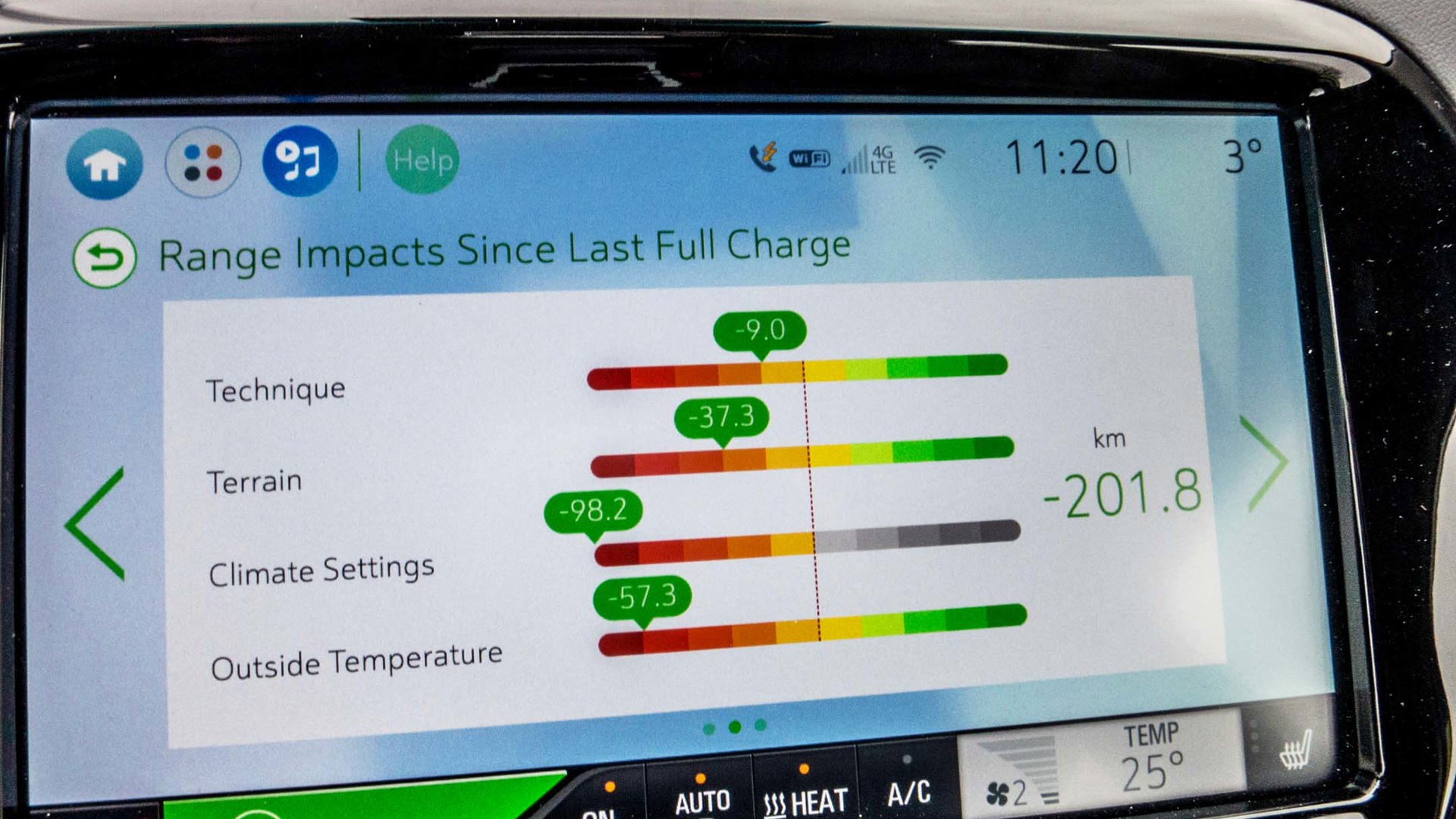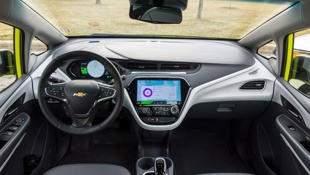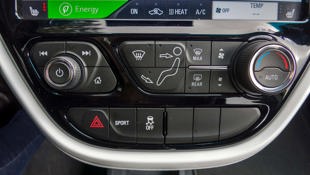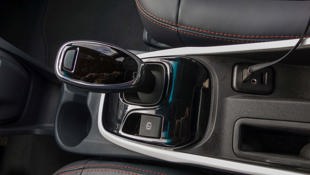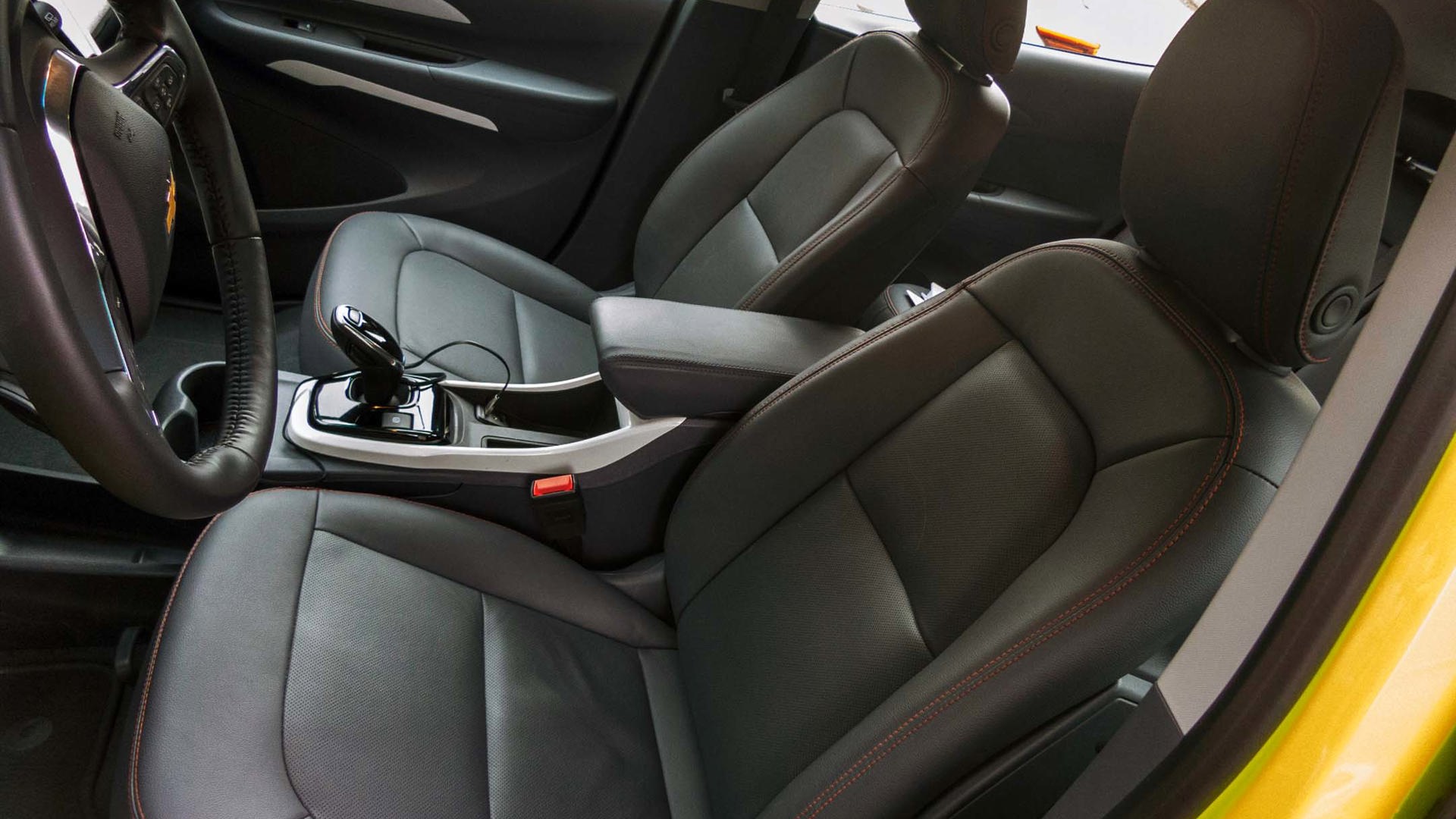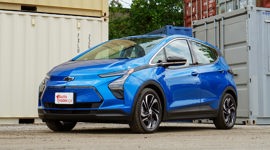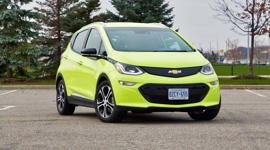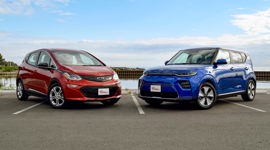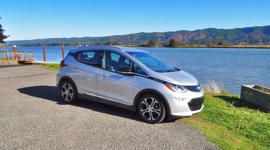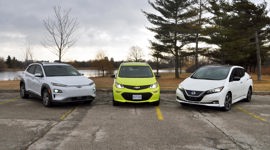 AutoTrader SCORE
AutoTrader SCORE
-
STYLING7/10
-
Safety7/10
-
PRACTICALITY8/10
-
USER-FRIENDLINESS7/10
-
FEATURES7/10
-
POWER8/10
-
COMFORT6/10
-
DRIVING FEEL8/10
-
FUEL ECONOMY9/10
-
VALUE6/10
I’d picked up the 2019 Chevrolet Bolt EV in Oshawa with a full charge, driven 80 km to Etobicoke, then spent the day doing drive loops for our autoTRADER.ca EV comparison test. About 60 km remained of the Bolt’s full 383 km range – impressive to be sure – but not enough to get me home to Peterborough. Fortunately, my Trader colleagues knew there was a Level 3 quick charger at the nearby IKEA, and best of all – it was free.
If EVs are going to gain mainstream acceptance, they’ll have to appeal to a wide range of people, and not just early adopters who flaunt the reverse cachet of driving a dorky planet-saver.
The Bolt EV was introduced in 2017, a time when manufacturers were hustling to bring the first affordable, long-range EV to market. Elon Musk and Tesla may have been garnering all the attention, but GM’s Chevy Bolt snuck in as the first EV under $40,000 (with rebates) to deliver nearly 400 km of range.
I’ve driven the Chevy Bolt several times and it’s one of my favourites in the EV category. Not only because of its impressive range, but its prodigious torque and flat-bottomed stability make it surprisingly delightful to drive. But what’s really remarkable about it? Just how unremarkable it is. Perhaps the Bolt’s greatest asset is that it blends in with every other conventional car on the road and normalizes the EV driving experience.
Styling: 7/10
One of the Bolt’s original claims to fame was that it looks more like a real car instead of a science experiment. If EVs are going to gain mainstream acceptance, they’ll have to appeal to a wide range of people, and not just early adopters who flaunt the reverse cachet of driving a dorky planet-saver. A tall, four-door hatchback, the Bolt looks like a raised-roof version of the Chevy Cruze hatch. Viewed head-on, the Bolt has a sharply defined, modern front end with a black, etched panel where the traditional grille would be. Black trim surrounds the slanted headlights, sweeping back to join the side mirrors in a fair imitation of Cleopatra’s smoky kohl-rimmed eyes. The charge port, located on the driver’s front fender, is the only obvious giveaway that the Bolt is anything other than your average compact grocery-getter. In fact, you probably wouldn’t even take a second glance at it if not for the colour. My tester’s “Shock” paint (a $495 option) is an iridescent lime-green with yellow flake which shimmers in the sunlight. Modest, it isn’t.
Although the cabin is clean and modern, quality was obviously sacrificed to deliver EV technology at the Bolt’s base price of $44,800. The dash and centre console are streamlined and uncluttered by knobs and buttons, but there’s an abundance of hard plastics.
Safety: 7/10
The base Bolt EV LT comes standard with electronic traction control, pedestrian safety signal, LED daytime running lamps, 10 airbags, OnStar and Chevrolet connected services, rear vision camera, LATCH system, Teen Driver (a configurable system that customizes vehicle settings, limits certain features, turns on safety systems, and provides an in-vehicle report), tire pressure monitoring system, tire fill alert. The Driver Confidence II package, previously equipped on the Premier trim only, is now available as an add-on for LT. It includes: low-speed forward automatic braking, lane-keeping assist, forward collision alert, following distance indicator, front pedestrian braking, and Intellibeam automatic high-beams.
Moving up to the Premier trim adds rear park assist, rear cross traffic alert, surround vision, lane-change alert with side blind zone alert. Surprisingly, there’s no adaptive cruise control available – surely a glaring omission in anything but the cheapest entry level vehicles these days. There is Chevrolet’s forward collision alert, a simple car graphic that turns from green to amber, stars issuing forth from its nose and tail, if you’re getting too close to the car in front. It’s no substitute for the stress relief of adaptive cruise control in stop-and-go rush hour traffic.
Practicality: 8/10
The amount of stuff you can pack into the Bolt is nothing short of astounding. Although it looks like a stubby hatchback, it’s an optical illusion created by the raised roofline – it’s a lot bigger than it looks. Trunk space is a generous 478 litres, which increases to 1604 litres with the rear seats folded down. That’s as much room as some small crossovers.
While there’s not much cubby space for rear passengers, up front there’s console storage under the armrest, and a shallow compartment in front of the shifter that’s just right for cellphones.
User Friendliness: 7/10
Vehicle technology is increasingly complex, and nowhere is this more frustrating for drivers than with a car’s interface. Scrolling through endless screens just to turn down the heat is not only frustrating – it’s dangerously distracting. Despite its sophisticated engineering, the Bolt is surprisingly simple to operate. Of course, there’s a bit of a learning curve for the driver who is new to electrification: determining how weather and driving style affects the car’s projected range, becoming familiar with charging stations and how to operate them, and learning how to maximize brake regeneration efficiency.
One of the best features of EVs is regenerative braking, which uses energy captured from the vehicle’s momentum while coasting, and stores it for future use. Behind the steering wheel, on the left side, is the Regen on Demand (RoD) paddle, which can be used to apply the maximum amount of regenerative braking force available without using the actual brake pedal. Regen is most effective when the vehicle is in “L” rather than Drive, and in this mode, with the exception of emergency braking, the Bolt can virtually be driven with one pedal.
The Bolt’s information screen is very clean and straightforward, with just a few clearly marked tabs instead of a bewildering cluster of tiny icons. Monitoring your power consumption is easy: just press the green tab marked “Energy” and the screen displays the information in easily legible figures. Tap anywhere near the large arrow to bring up the next level of energy information, or “Home” to access Apple CarPlay or Android Auto. The Bolt also features programmable charging, so you can set the car to start charging immediately, or at a certain time of day when utility rates are cheaper.
The biggest drawback to the Bolt’s usability isn’t the car itself – but the lack of infrastructure. Road trips take extra planning to ensure the route includes access to a charging station. And if you use your smartphone to operate the station, you need to make sure your phone is charged, and that it’s within range.
Comfort: 6/10
While the Bolt surpasses competitors Nissan Leaf and Hyundai Kona EV in driving dynamics, it falls short on comfort. The vinyl-surfaced seats are flat and there’s no available power adjustment. The abundance of hard plastics makes the cabin feel cheap and spartan, and doesn’t do much for interior acoustics either. Even a simple rubber liner in the cupholders or storage cubbies to mute any rattling would’ve been a welcome touch.
Driving position is good though, and occupants are seated high and afforded clear vision through the expanse of glass. There’s plenty of head- and legroom for both front and rear passengers, but not much room between shoulders. Standard on both trims is a heated steering wheel.
Driving Feel: 8/10
Since most of the vehicle’s weight is concentrated under the floor, the Bolt is extremely stable, exhibiting almost no body roll. Like most electric vehicles, its readily available torque makes it instantly responsive, to the point where it’s easy to embarrass yourself with an unintended tire squeal at stoplights. On the road, the Bolt handles well, is fairly quiet and despite its height, and remains stable during crosswinds.
It doesn’t take very long to master the art of one-pedal driving, and since the Energy screen has a score for technique, it made it very compelling to try to improve my efficiency.
Recently, I took a Bolt to an autocross competition held by the local motorsport club. In a field dominated by Miatas, Mustangs, and even a Lotus Elise, I came about mid-pack – and that was on all-season Eco tires. With a set of good rubber, the Bolt would be pretty competitive on a small course with lots of tight turns, since it’s able to get back up to speed so quickly after cornering.
Power: 8/10
With 200 horsepower and 266 lb-ft of torque, the Bolt has no trouble keeping up during highway driving. Torque delivery is immediate, making the Bolt delightfully responsive, and quite adept at passing speeds. The electric motor is mated to a single-speed transmission and differential directly connected to the front wheels – so very little horsepower is lost through the driveline. With no gear changes to perform, the transmission’s power delivery is smooth and linear, without any of the lag or gear hunting of a traditional automatic unit.
Fuel Economy: 9/10
Home charging wasn’t an option, so for the duration of my test, I used only Level 3 quick charging stations at $15.00/h before taxes. If the battery was nearly depleted, it would take a little over an hour to fully recharge.
The driver’s information screen shows both minimum and maximum range, depending on the temperature, driving style, and speed. Unlike the Kona EV, BMW i3, or Nissan Leaf, there’s no Eco Mode to lock out such energy-sucking features as cabin heat and seat warmers. It’s up to the driver to weigh energy expended vs comfort.
For instance, during 517 km of travel, I’d used 113.5 kWh of energy. Of that, 86 percent was used to power the car and accessories, and 14 percent was used for climate control. Overall, I averaged 21.9 kWh/100 km over highway and city driving, which translates to roughly 2.5 L/100 km. During winter – in addition to reduced battery capacity due to the cold – the percentage used for climate control would probably be higher, affecting the overall energy consumption.
Features: 7/10
The $44,800 LT entry-level trim comes equipped with a long list of standard features, including: projector high-beams, remote start, heated power-adjustable mirrors, cruise control, Teen Driver mode, Apple CarPlay and Android Auto, Bluetooth, Sirius XM satellite radio, heated front seats, two USB ports, pedestrian safety signal, and rear back-up camera.
Premium $49,800 models add a package of safety features that include side blind zone and lane change alert, rear cross-traffic alert, rear park assist, and surround vision bird’s-eye view. They also get an auto-dimming camera rear-view mirror, Bose premium sound, wireless smartphone charging, Ultra-Bright machined aluminum wheels, and roof rack rails.
But its leatherette seats are manually adjustable – in fact, you can’t get power-adjusting seats at any trim level. There’s also no onboard navigation system, which means you’ll have to rely on your phone. Fortunately, my press car had onboard Wi-Fi (available with subscription), and I was able to use car’s data coverage for my navigation needs.
Value: 6/10
Until last year, Ontario drivers could receive up to $14,000 in rebates when purchasing a hybrid or electric car. That program has since been cancelled; however, a new federal incentive will return up to $5,000 on any car with a base model under $45,000. Even with the rebate, however, the average consumer looking at practical compact cars might find it hard to justify the Bolt’s $44,800 entry price.
But the interest in electrified vehicles is growing far beyond its original niche market and has moved mainstream. While fuel prices remain one of the biggest incentives for buyers transitioning from conventional combustion vehicles to hybrid or electric, there’s also a rising concern for the environmental impact of fossil fuels. The number of available vehicles has therefore expanded and dedicated EV buyers can now afford to be choosy.
Competitor Nissan Leaf is the segment’s top seller at $36,798 – but its rated range is only 240 km compared to the Bolt EV’s 383 km. Opt for a Leaf Plus and you get 349 km of range for $52,048. Hyundai’s Kona boasts 415 km in range but is more expensive at $51,999 to start. For 2020, the Kia Soul bumps its range up to 391 km, with a buy-in price of $42,595.
Conclusion
Practical, fun-to-drive, and with great handling, the Chevrolet Bolt EV has a lot going for it. But it’s not cheap, and it’s let down by inferior cabin materials. With so many more competitors entering the electrified arena, buyers can afford to raise their expectations.
Still, the Bolt EV is well worth a look if you’re shopping for an electric vehicle.
| Engine Displacement | 150 kW electric motor |
|---|---|
| Engine Cylinders | N/A |
| Peak Horsepower | 200 hp |
| Peak Torque | 266 lb-ft |
| Fuel Economy | 1.8/2.1/2.1 Le/100 km cty/hwy/cmb, 16.4/19.0/17.6 kWh/100 km cty/hwy/cmb |
| Cargo Space | 479 / 1,603 L seats down |
| Model Tested | 2019 Chevrolet Bolt EV Premium |
| Base Price | $49,800 |
| A/C Tax | $100 |
| Destination Fee | $1,795 |
| Price as Tested | $53,045 |
|
Optional Equipment
$1,550 – Driver Confidence II Package $795; Shock $495; Black Bowtie Emblems $260
|
|
